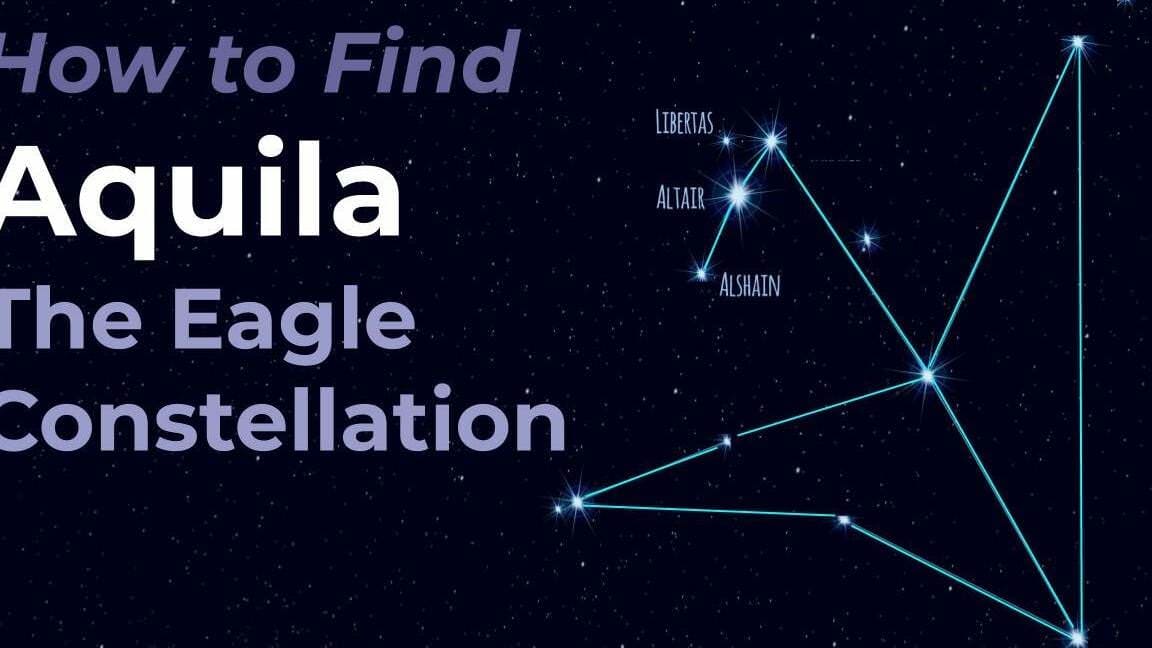The original article on the Eagle Constellation contains numerous illustrations implemented with the help of JavaScript, which may not be visible on certain devices. However, this page provides all the images for your viewing pleasure.
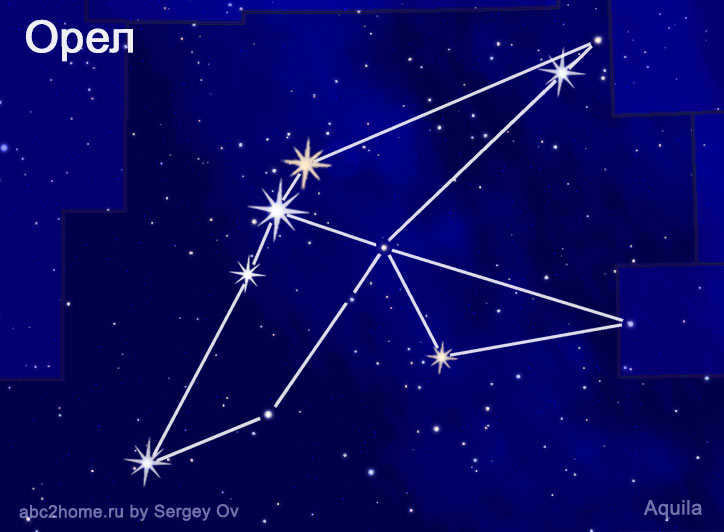
Schematic of Figure 1.Aql. The constellation Eagle is depicted in the image above.
The Eagle constellation, also known as Aquila, is the oldest constellation in the Hercules group. It has been represented in star drawings for over 3000 years, dating back to the Ancient Babylonians. The constellation is divided into two parts by the celestial equator, with the larger part belonging to the Northern Hemisphere. As a result, it is classified as a northern equatorial constellation. In terms of its ranking in the entire celestial sphere, Eagle holds the twenty-second position. Among the constellations of the Northern Hemisphere, it ranks thirteenth with an area of 652 sq. deg., following the constellation of Ascendant. Eagle is bordered by nine other constellations, including Arrow, Hercules, Serpent, Serpent’s Tail, and Shield, as well as Sagittarius, Capricorn, Aquarius, and Dolphin. In Russia, Eagle is fully visible in the western sky, with a declination ranging from -11.9° to 18.7°. The constellation reaches its highest point in the sky at midnight during mid-summer and remains there for the entire month of July, from early to late. This is why Eagle is considered a summer constellation. In Moscow, Eagle can be observed from February to December.
The figure below displays the boundaries of the constellation and the majority of the observable stars. The view of the constellation Eagle, known as 2.Aql, is depicted at its highest point of culmination. This representation is commonly used in the field of astronomy to showcase constellations.
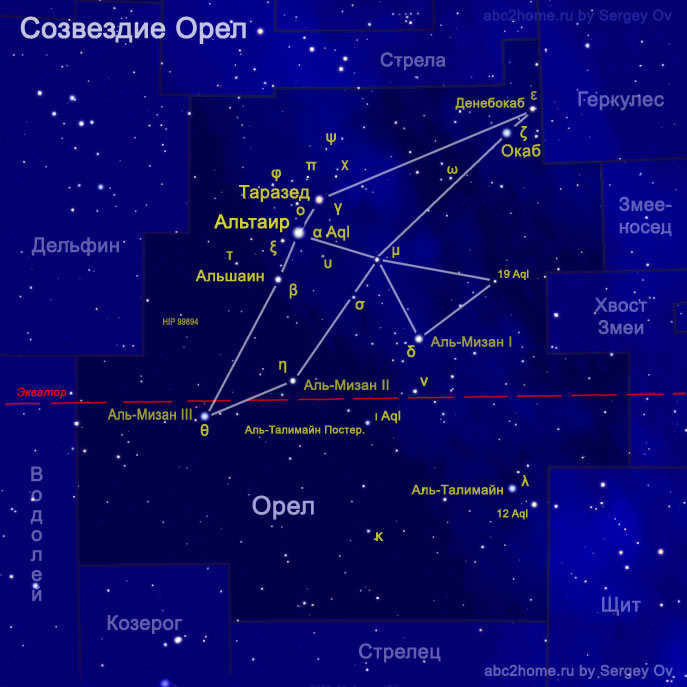
Figure 2.Aql. The constellation of the Eagle. The names of the most prominent stars historically established and approved by the International Astronomical Union (IAU).
By referring to this illustration, you can practice sketching the outlines of the Eagle constellation. Hovering over the figure 2.Aql will reveal only the stars. To view a larger image of the constellation’s stars in full screen, click on the figure.
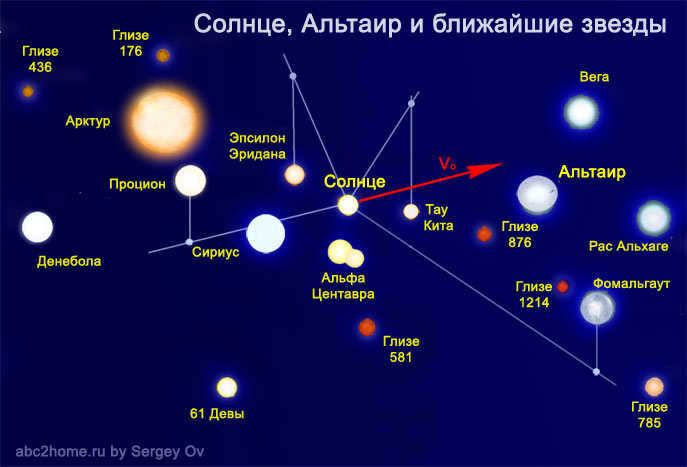
Fig. 3.Aql. Altair, the Sun, and neighboring stars
Altair is projected to become a close neighbor in the Solar System in approximately 6000 years.
Altair, which is about a billion years old, is considered an intermediate age star for its class, and has a higher metallicity compared to the Sun.
Altair, along with its prominent summer triangle companion Vega (Fig.3 Lyr), exhibits a rapid rotation on its axis. Its equatorial rotation speed is estimated to be 200 km/s (with a surface destruction rate of 450 km/s). In contrast, the Sun’s equatorial rotation speed is just over two kilometers per second (7284 km/h ≈ 2 km/s). Altair rotates a hundred times faster than the Sun, resulting in an ellipsoidal shape with a diameter ratio of 22% (Fig. 4.Aql.).
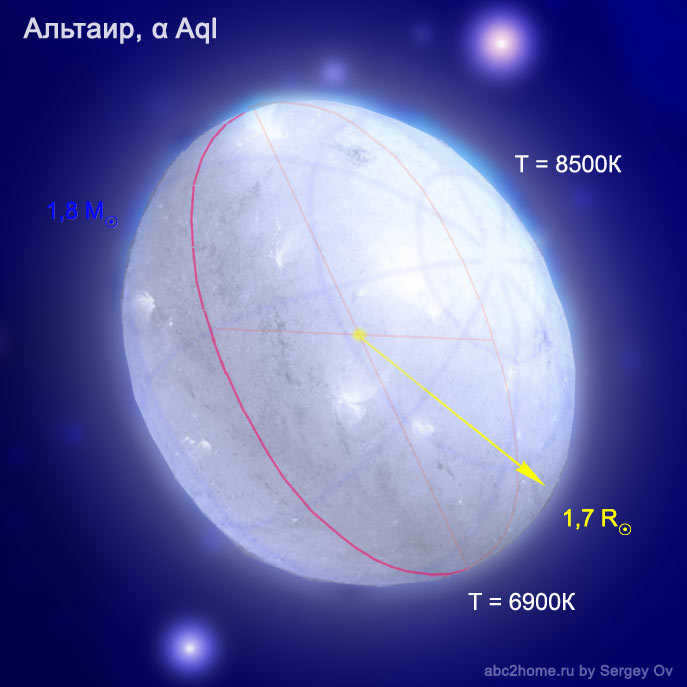
Figure 4.Aql. A sketch of Altair, α Aql, which is based on data from the CHARA interferometer
Fortunately for our solar system, Altair, our very close neighbor, has a mass of approximately 1.8 M⊙ and will never undergo a supernova. Its hydrogen supply is expected to last for another billion years, give or take, before it evolves into a red giant.
The constellation pattern for the Eagle star has been chosen based on the most proportional representation of a soaring eagle, although there is a slight violation of the constellation boundaries. However, no one would mistake it for a chicken or a pterodactyl (Fig.5.Aql.) :
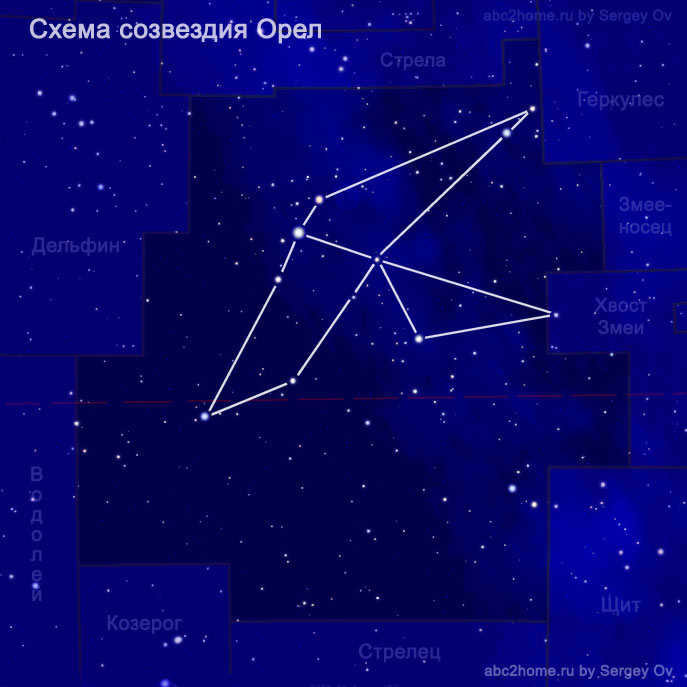
The constellation known as the Eagle showcases a magnificent diagram that depicts a soaring eagle. This stunning portrayal of the Eagle constellation has been expertly crafted by Sergey Ov.
Fig. 5.Aql. The constellation Aquila, also known as Eagle in Latin, is represented by a diagram of stars in the shape of a soaring eagle. To see the names of the stars, hover your cursor over the figure with JavaScript enabled. This is the author’s version of the star chart, depicting the Eagle constellation. It shows a schematic visualization of the Eagle made up of stars, as presented in figure 5.Aql. The Eagle constellation is already used in the planetarium map called “Starry Sky of Russia.” In figure 6.Aql, there are four alternating schematic images of stars that can be observed during the culmination of the constellation: 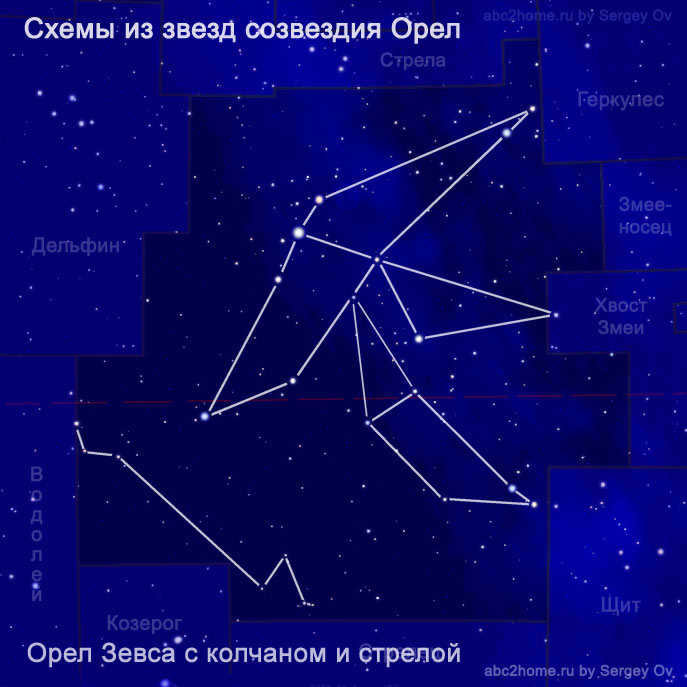 Figure 6.1.Aql. Eagle with the quiver of Zeus, schematic by S. Ov
Figure 6.1.Aql. Eagle with the quiver of Zeus, schematic by S. Ov 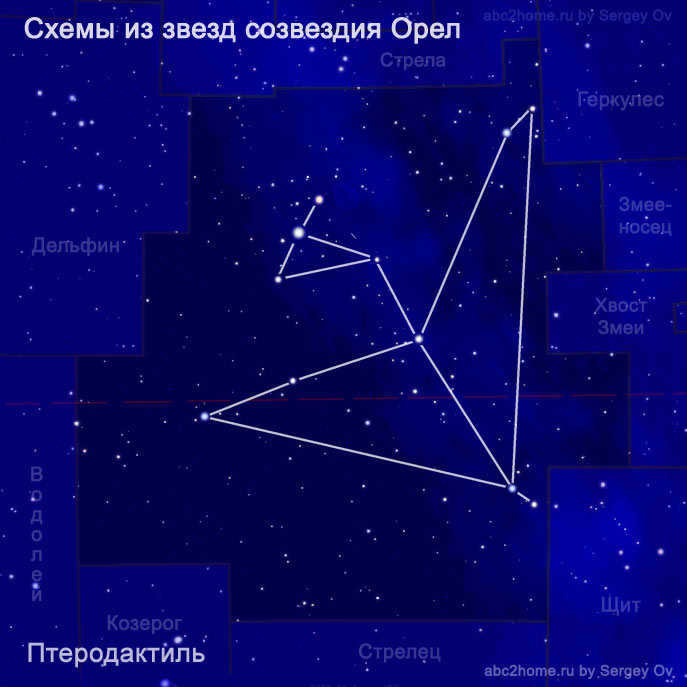 Fig. 6.2.Aql. Pterodactyl
Fig. 6.2.Aql. Pterodactyl 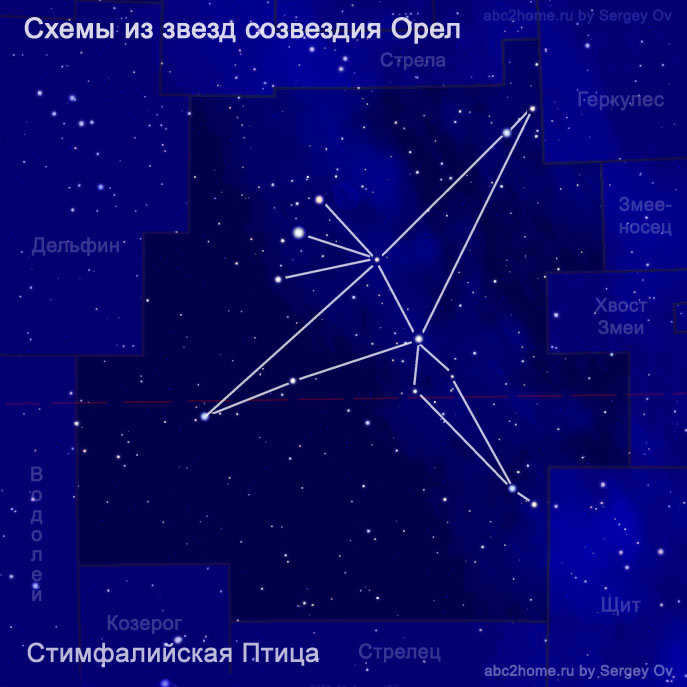 Fig. 6.3.Aql. Stymphalian Bird
Fig. 6.3.Aql. Stymphalian Bird 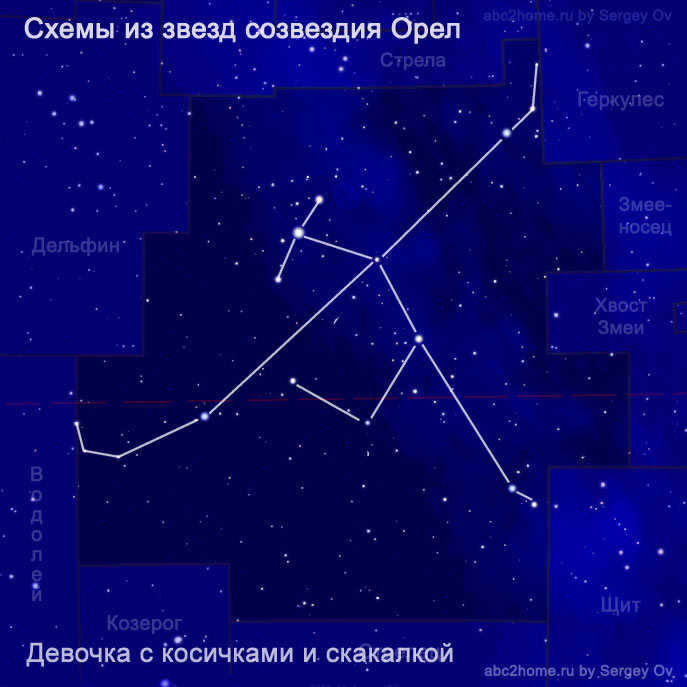 Fig. 6.4.Aql. Girl with pigtails and jump rope, scheme by S. Ove
Fig. 6.4.Aql. Girl with pigtails and jump rope, scheme by S. Ove
Figures 6.Aql. These are different schematic images of the stars of the Eagle constellation observed during its culmination. It is interesting to observe how the views of the Eagle constellation have evolved from the time of Claudius Ptolemy to the present day. The first three schematic images in figure 7.Aql illustrate this evolution: 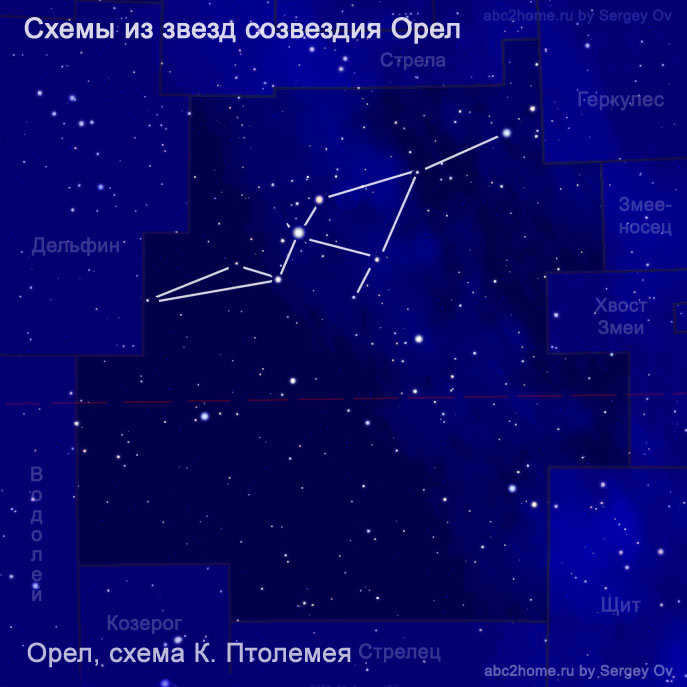 Figure 7.1.Aql. Eagle, schematic by C. Ptolemy
Figure 7.1.Aql. Eagle, schematic by C. Ptolemy 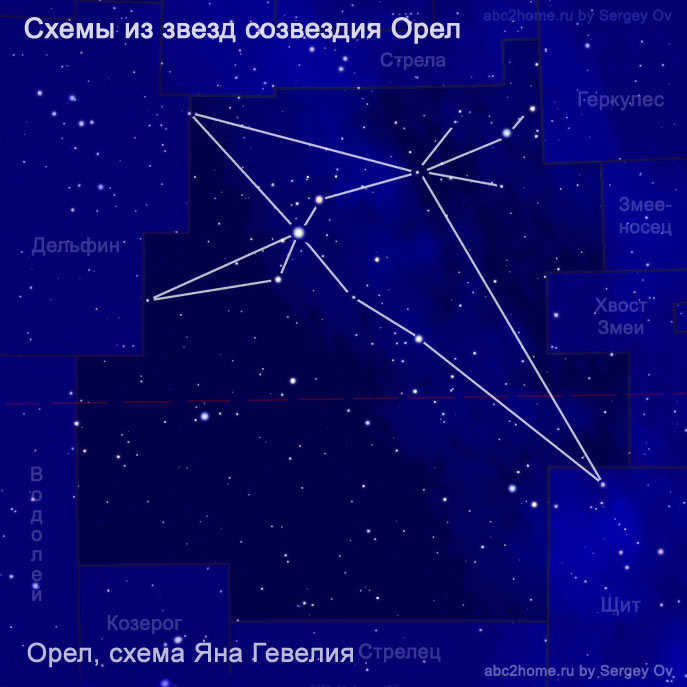 Fig. 7.2.Aql. Eagle, scheme by Jan Hevelius
Fig. 7.2.Aql. Eagle, scheme by Jan Hevelius 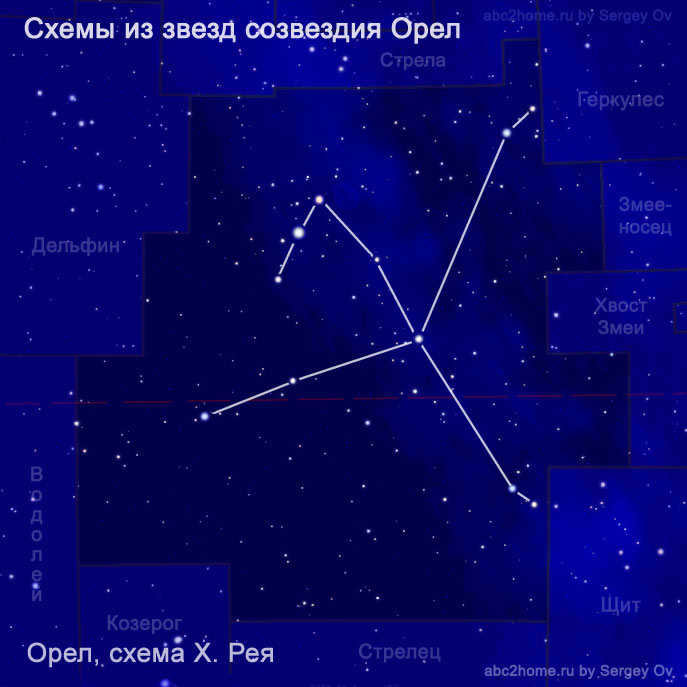 Fig. 7.3.Aql. Eagle, scheme by H. Rey
Fig. 7.3.Aql. Eagle, scheme by H. Rey 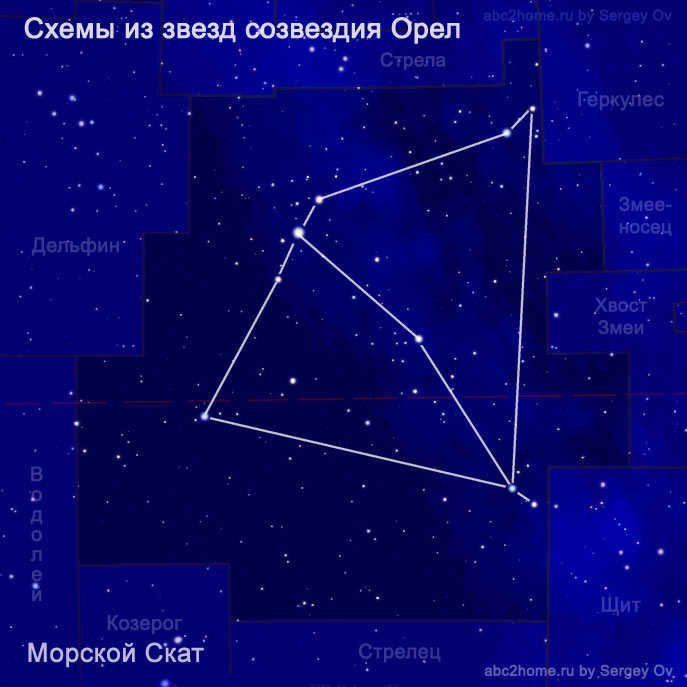 Fig. 7.4.Aql. Sea Scat Figures 7.Aql. These are drawings made from the stars of the Eagle constellation. The direction from East to West is also fruitful for creating schematic drawings. In figure 8.Aql, there is a set of schematic images of stars that can be imagined when observing the constellation from the East:
Fig. 7.4.Aql. Sea Scat Figures 7.Aql. These are drawings made from the stars of the Eagle constellation. The direction from East to West is also fruitful for creating schematic drawings. In figure 8.Aql, there is a set of schematic images of stars that can be imagined when observing the constellation from the East: 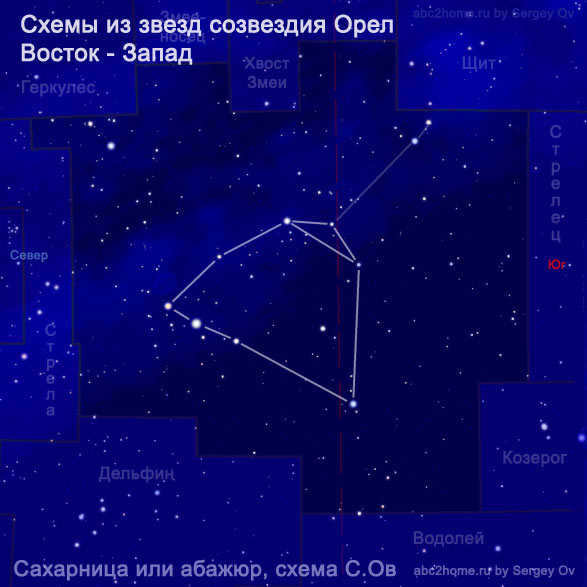 Figure 8.1.Aql. Lampshade or sugar bowl, schematic by S.Ov
Figure 8.1.Aql. Lampshade or sugar bowl, schematic by S.Ov 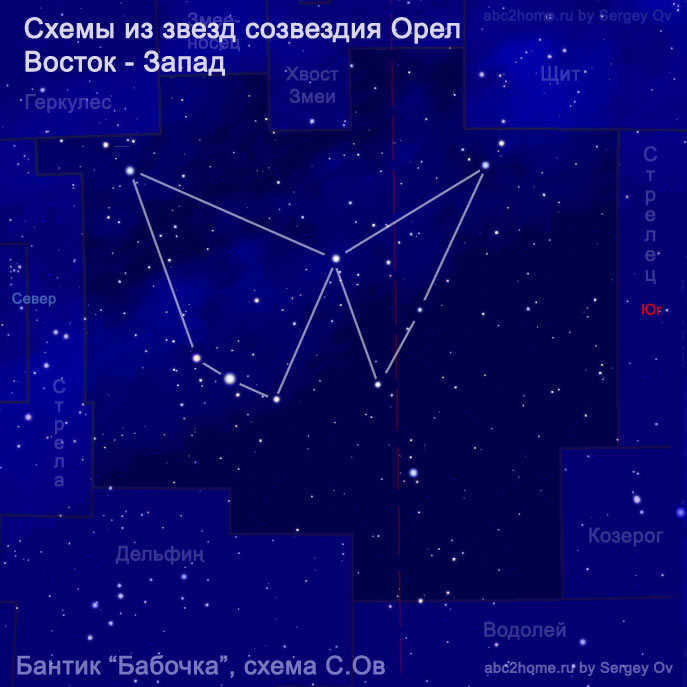 Fig. 8.2.Aql. Butterfly bow, scheme S.Aql.
Fig. 8.2.Aql. Butterfly bow, scheme S.Aql. 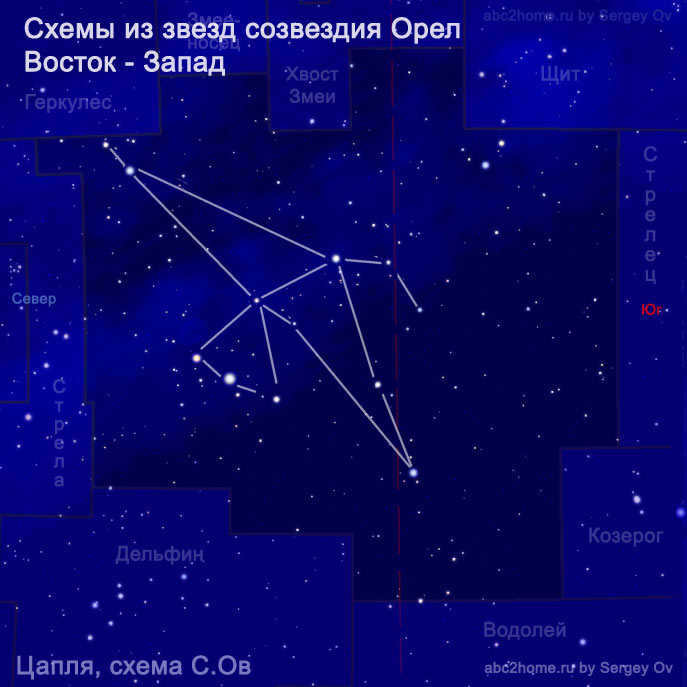 Fig. 8.3.Aql. Heron, scheme S.Ov
Fig. 8.3.Aql. Heron, scheme S.Ov 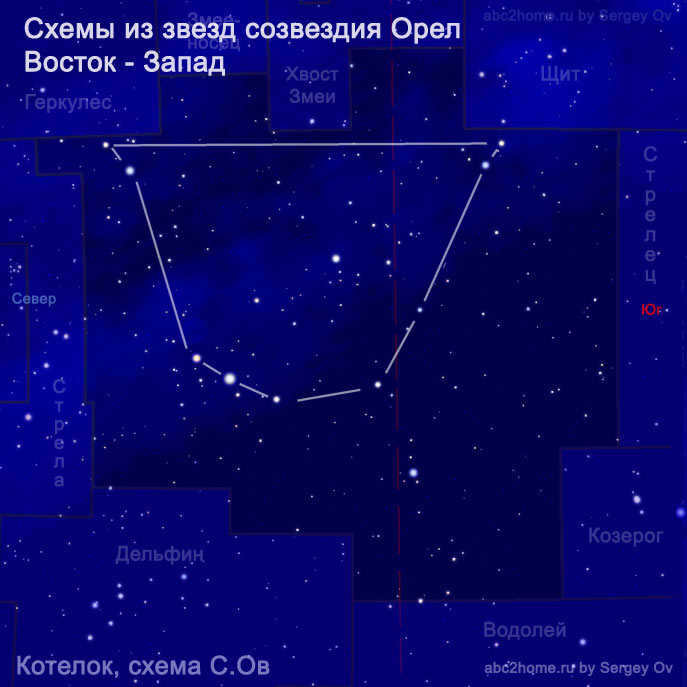 Fig. 8.4.Aql. Wok, scheme S.Ov Figures 8.Aql. These are drawings made from the stars of the Eagle constellation when observed from East to West. When observing the constellation from North to South, the modern observer can imagine various images that fill the allotted area to the maximum. Some examples include a sailing yacht, a skier on a ski jump, a dragon, and the ace of spades. These are depicted in figures 9.Aql:
Fig. 8.4.Aql. Wok, scheme S.Ov Figures 8.Aql. These are drawings made from the stars of the Eagle constellation when observed from East to West. When observing the constellation from North to South, the modern observer can imagine various images that fill the allotted area to the maximum. Some examples include a sailing yacht, a skier on a ski jump, a dragon, and the ace of spades. These are depicted in figures 9.Aql: 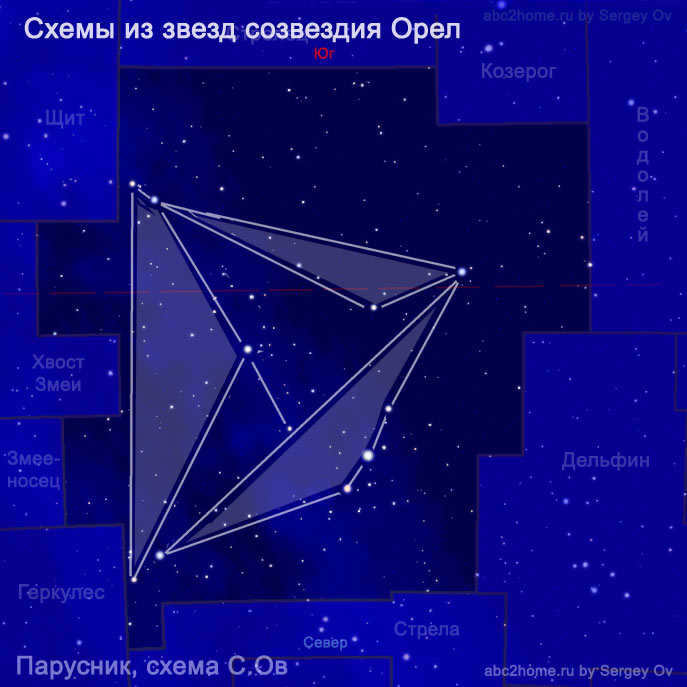 Fig. 9.1.Aql. Sailboat, scheme S.Ov
Fig. 9.1.Aql. Sailboat, scheme S.Ov 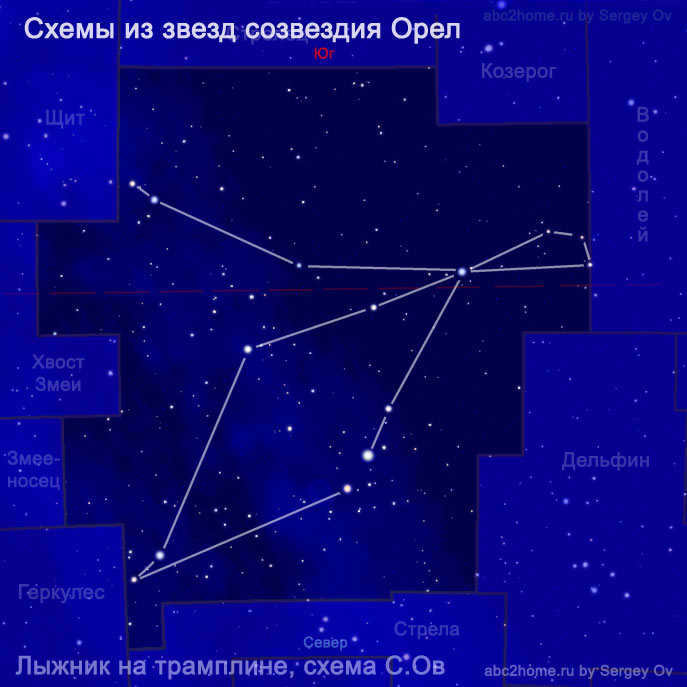 Fig. 9.2.Aql. Skier on a ski jump, scheme S.Ov
Fig. 9.2.Aql. Skier on a ski jump, scheme S.Ov 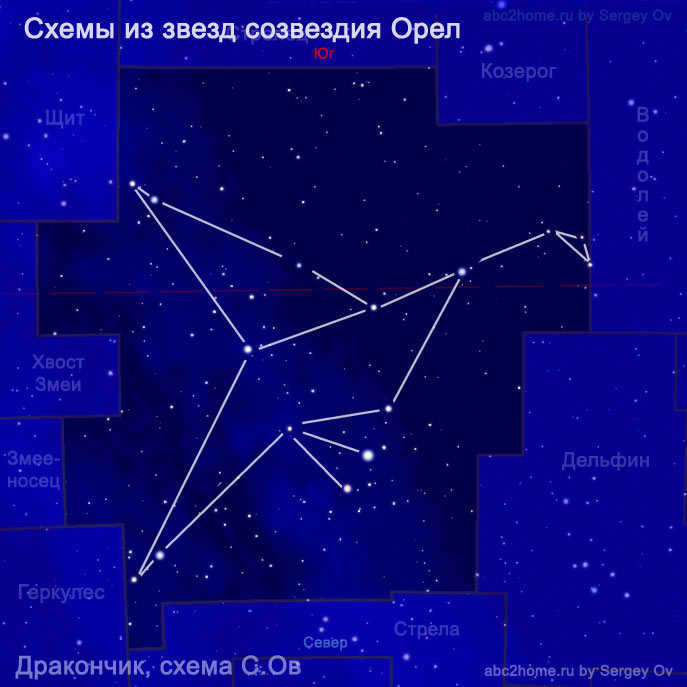 Fig. 9.3.Aql. Dragon, scheme S.Ov
Fig. 9.3.Aql. Dragon, scheme S.Ov 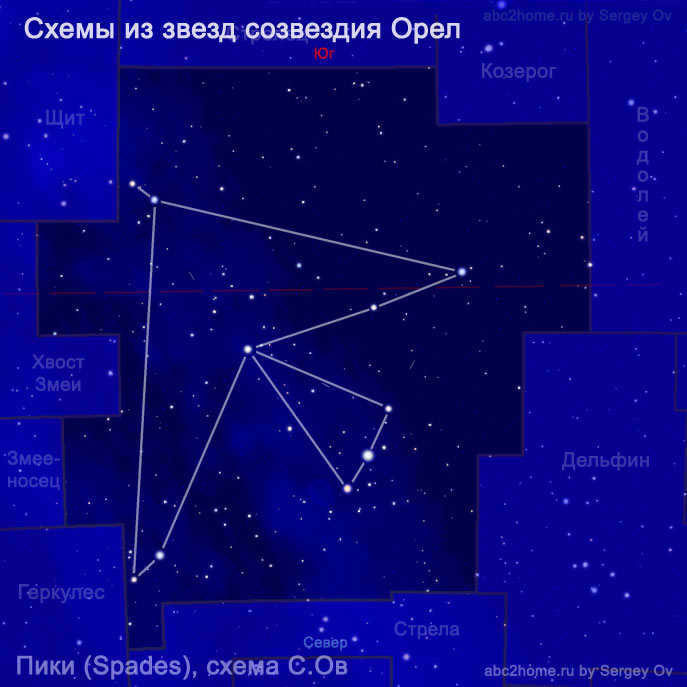 Fig. 9.4.Aql. Spades, vini (slades), scheme S.Ov. Figures 9.Aql. These are schematic drawings constructed when observing the Eagle constellation from West to East. Finally, when observing the constellation from West to East, the largest drawing that fills almost the entire space is a pastoral image of a girl with a sickle, depicted in figure 10.Aql.
Fig. 9.4.Aql. Spades, vini (slades), scheme S.Ov. Figures 9.Aql. These are schematic drawings constructed when observing the Eagle constellation from West to East. Finally, when observing the constellation from West to East, the largest drawing that fills almost the entire space is a pastoral image of a girl with a sickle, depicted in figure 10.Aql.
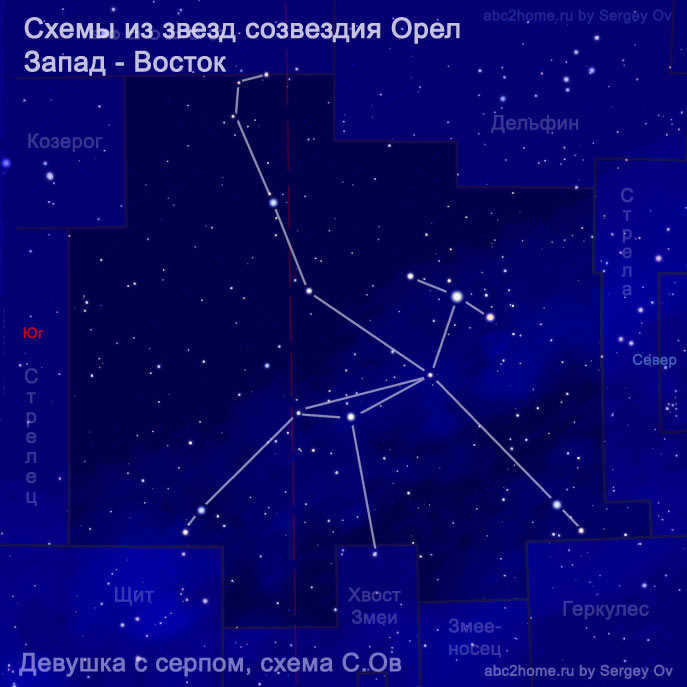
The constellation Eagle is depicted in the contour drawing titled “Girl with sickle” – a diagram created by Sergey Ov.
Fig. 10.Aql. The schematic drawing of the stars in the constellation Eagle is represented by the image of a girl with a sickle.
To view the names of the stars, hover your cursor over the edges of the figure. The pictorial possibilities of the constellation Eagle are not limited to the drawings shown here. There is still a vast reserve for the imaginative minds of readers to explore. Feel free to share your own schematic drawings on the forum!
For young stargazers:
The optimal period for observing the Eagle constellation is during the latter part of summer, coinciding with school breaks. However, it is also visible in September and even November, appearing in the evening sky in the western direction. Amidst the summer season, when the earth is warmed by the sun and warm air currents rise, flying kites becomes a pleasurable activity. Interestingly, the Eagle constellation itself contains a kite-shaped formation (Fig. 11.Aql) that doesn’t require actual flying but merely necessitates the ability to spot it.
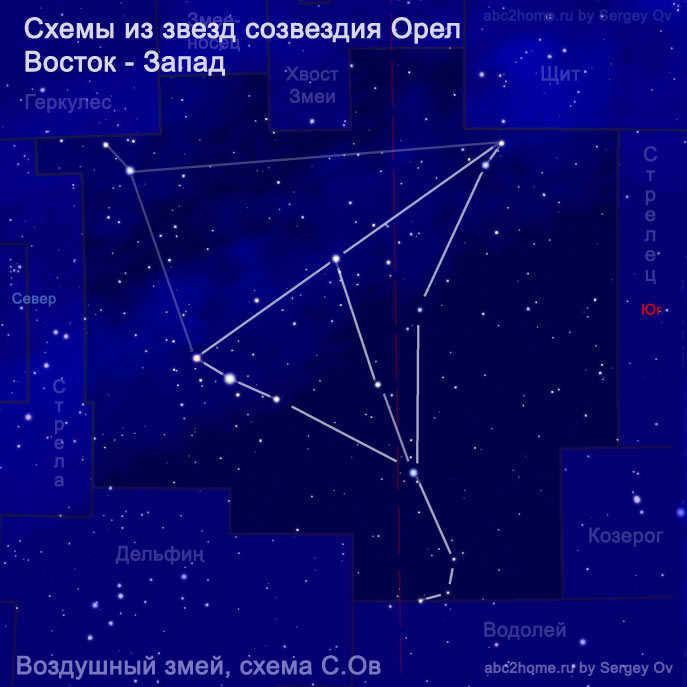
The constellation known as Eagle is depicted in the contour drawing titled “Kite” in the diagram. The diagram was created by Sergey Ov. Sergey Ov is the author of this particular diagram.
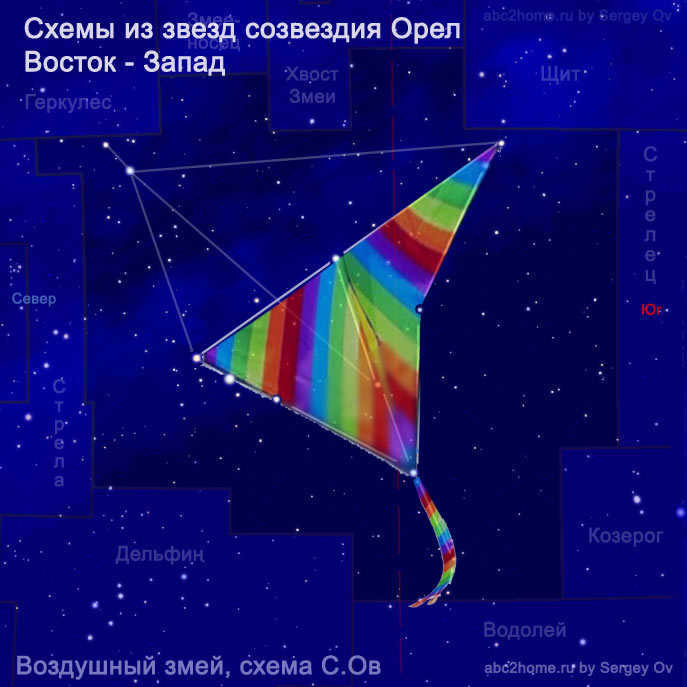

Kite sketch by Sergey Ov
Figures 11.2.Aql. Kite illustration
Figures 11.AqlThe Kite represents the connection of stars in the constellation Eagle. To view the Kite, it is necessary to face east and wait for the constellation’s lower edge to be sufficiently above the horizon. It is important to note that all the illustrations in this section should be viewed facing east.
The construction of figure 11.Aql incorporates almost all of the brightest stars in the Eagle constellation. By carefully positioning the cursor near the edges of the figure, a beautiful and vibrant kite can be observed. Additionally, another memorable illustration formed by connecting the brightest stars is a portrait of an Alien Insectoid (ant):
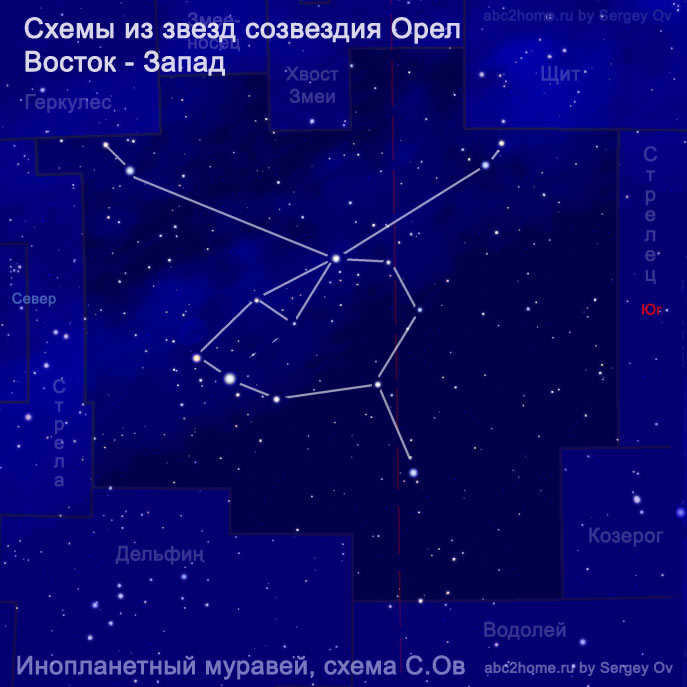
The Eagle constellation is depicted in a contour drawing titled “Alien Ant: Trunks” by Sergey Ov. Sergey Ov is the author of this diagram.
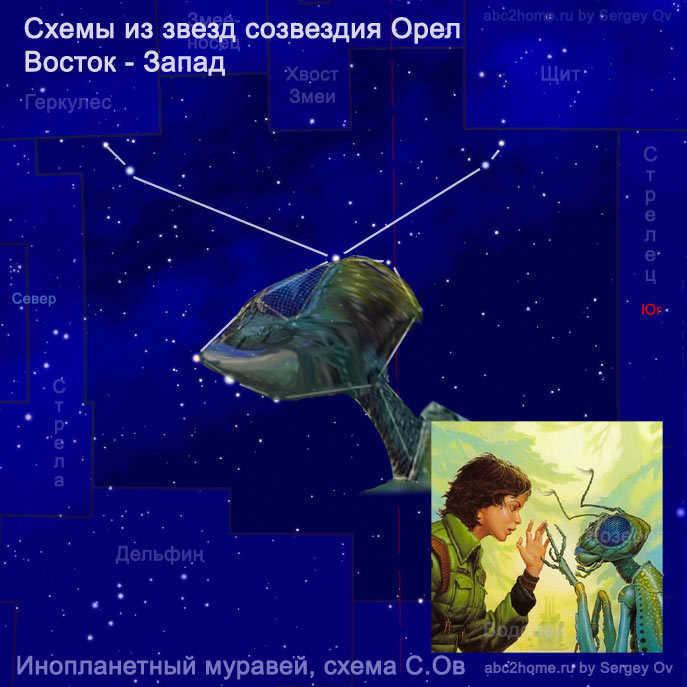

Sergey Ov presents a unique Trunks pattern inspired by the Alien Ant.
Fig. 12.2.Aql. Extraterrestrial ant: Trunks figure from the publication
Figure 12.Aql. Extraterrestrial Ant (Insectoid): Trunks – drawing made from connecting the dots between the stars of the constellation Eagle. Hover or gently touch the drawing on the touch screen 12.Aql and you will see a depiction of the insectoid trunks from Alan Dean Foster’s fantasy series of novels “The Adventures of Flinx“, as well as a fragment of an illustration for a book in the series titled “The End of Matter”. If you have visited the pages of the website dedicated to other constellations, you may have noticed that many of them feature images of furry creatures from the feline family. The gallery of stellar cat drawings is rapidly expanding, which led us to the idea:
– What if there are star cats hiding in every constellation?
We decided to test this idea by further describing the constellations and thereby prove, in a way, the theorem “On the behavior of star cats and cats.”. Theorem:
In every sufficiently large constellation, there may be a Star Cat lurking. Those familiar with Lewis Carroll’s “Alice in Wonderland” will also understand the following axiom:
In any constellation, you can find traces of the Cheshire Cat’s smile.. “Cats that didn’t smile, I’ve seen often,” thought Alice. – But a smile without a cat! That’s the most incredible thing I’ve ever seen here».
(Lewis Carroll. Alice in Wonderland.
Chapter six. The piglet and the pepper. ) This axiom is easily confirmed – the traces of the Cheshire Cat’s smile do not need to be looked for long, it hides in the wings of the Eagle: (Fig. 5.Aql).
The Cat in the Eagle constellation was found when looking from east to west (And what a cat!)and its image is shown in Figure 13.Aql: The Eagle constellation. Contour drawing “Star Cat, which walks by itself” – diagram. Diagram created by Sergey Ov
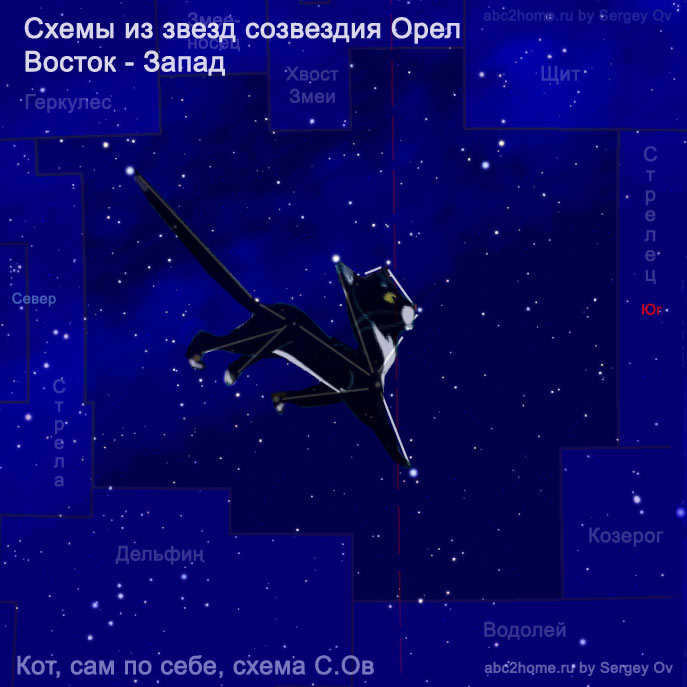
A drawing of a cat that walks by itself – created by Sergey Ov
Fig. 13.1.Aql.A cartoon drawing of a cat who walks by himself
Figure 13.Aql. The Star Cat Who Walked by Himself – a drawing of a cat from the stars of the constellation Eagle. To confirm that this is indeed the cat, simply move the cursor over the drawing or touch it on the touch screen and you will see the image of a black cat with a white chest from the cartoon “The Cat Who Walked By Himself“. This drawing is based on Rudyard Kipling’s tale “The Cat That Walked by Himself”. The Star Cat in the constellation of Eagle has been discovered. The theorem has been proven.
Asterisms of the Eagle Constellation
The most ancient asterism within the Eagle constellation, which can be likened to the star pattern of the flaming sword of Shamash, assumes that the Ancient Sumerians possessed the ability to conceive divine entities as separate from a god.
Figure 14.Aql showcases the asterism of the flaming sword of Shamash, wherein the majority of the stars align with the current boundaries of the Eagle constellation:
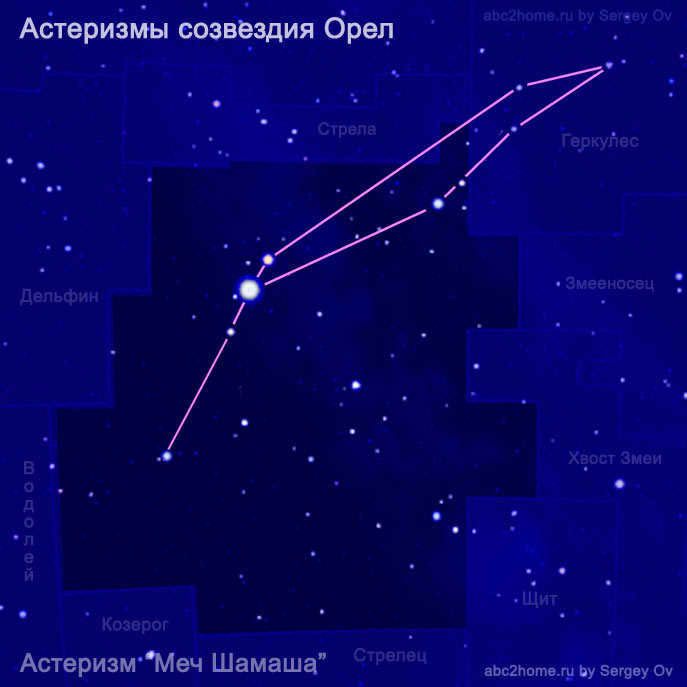
The Eagle constellation is represented by the “Sword of Shamash”. This diagram depicts the contour drawing of the sword. The diagram was created by Sergey Ov.
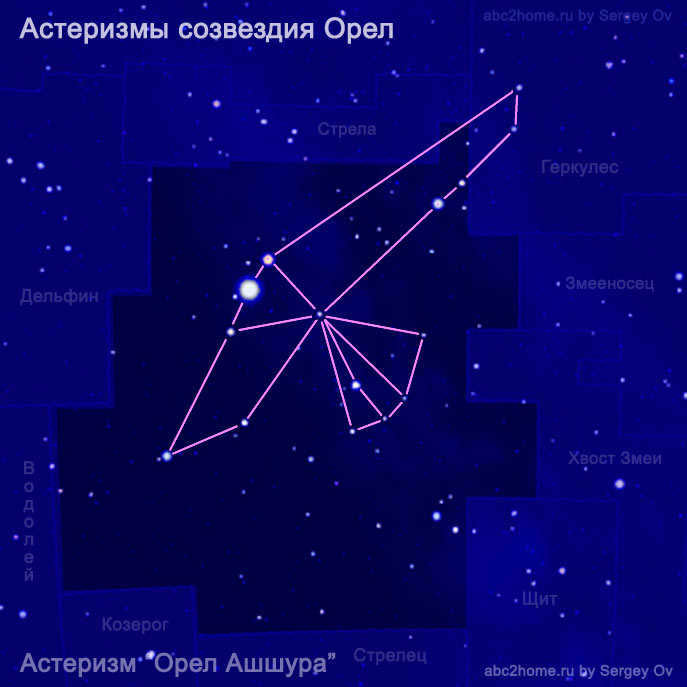
The constellation known as Fire Eagle is depicted in the image above. It was captured by Sergey Ov.
Fig. 14.2.Aql. The image known as “The Eagle of Ashshur” is created by connecting the stars in the constellation Eagle with lines:
Figures 14.Aql. The ancient asterisms “The Fiery Sword of Shamash” and “Eagle of Ashshur” are representations made by connecting the stars in the constellation Eagle with lines
In Figure. 15.Aql. a series of asterisms, which are not as ancient but still well-known, are presented in order to easily identify the constellation of the Eagle: 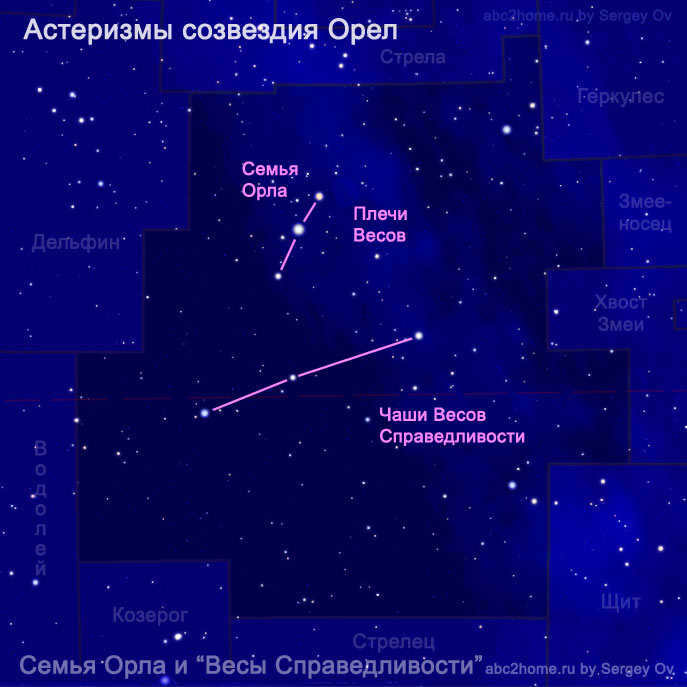 Fig. 15.1.Aql. Asterisms Family of Eagle and Libra Bowl asterisms
Fig. 15.1.Aql. Asterisms Family of Eagle and Libra Bowl asterisms 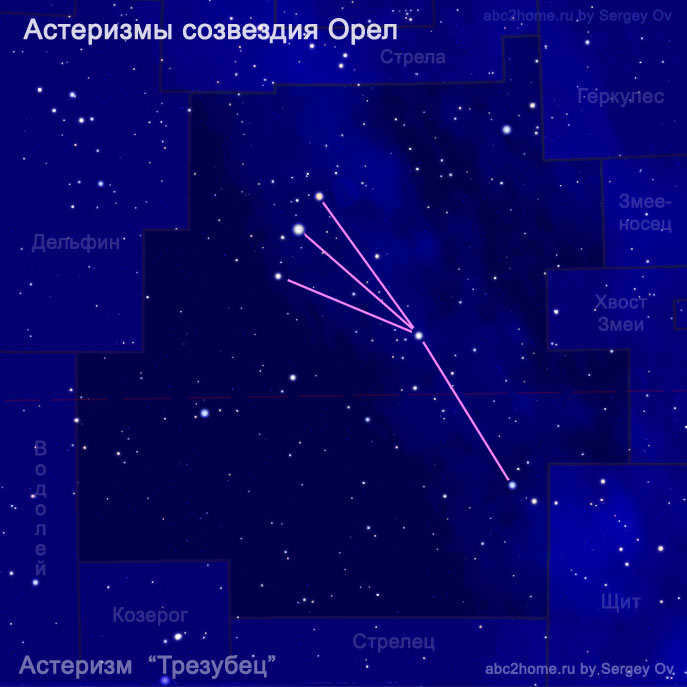 Fig. 15.2.Aql. Asterism Trident (Trident)
Fig. 15.2.Aql. Asterism Trident (Trident) 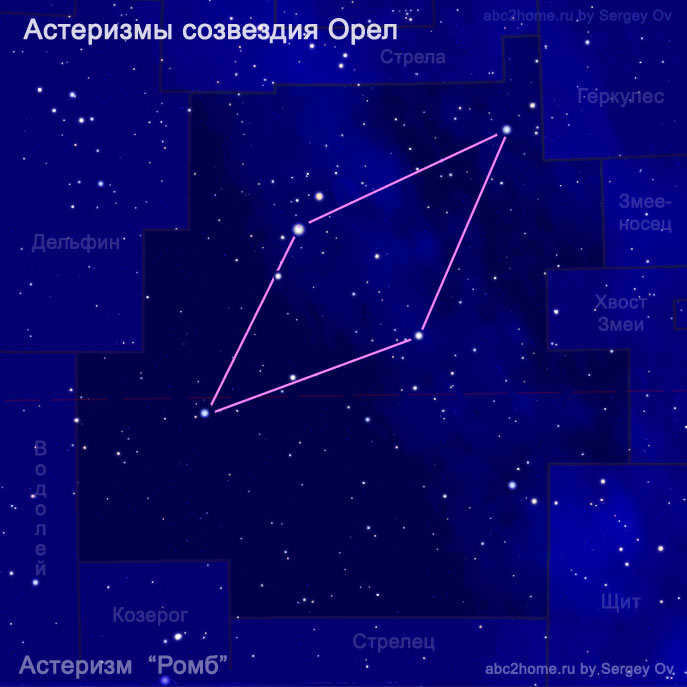 Fig. 15.3.Aql. Asterism Rhombus
Fig. 15.3.Aql. Asterism Rhombus 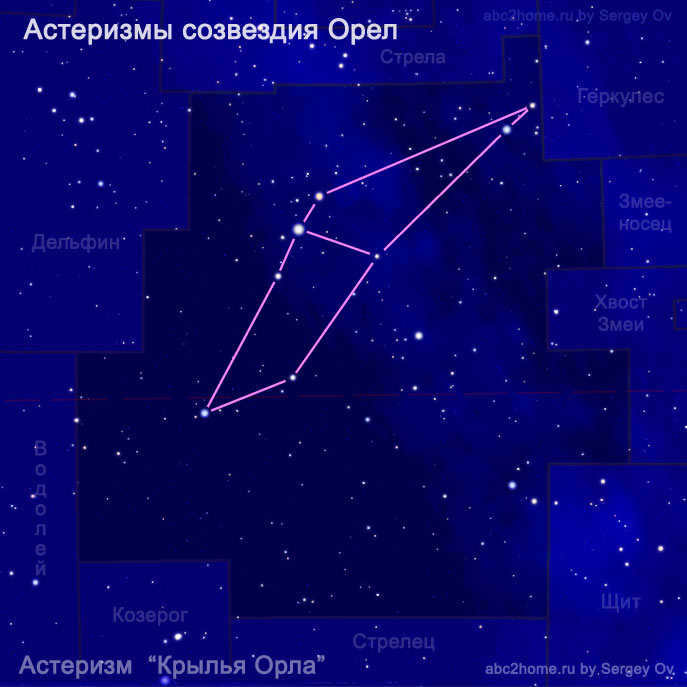 Fig. 15.4.Aql. Asterism Wings of the Eagle Fig. 15.Aql. Drawings of asterisms created from stars in the constellation Eagle’s Wings Asterisms can be made either within the constellation or based on the brightest stars from various constellations. The constellation Eagle plays a role in the creation of the seasonal asterism known as the Summer Triangle (Summer-Fall).
Fig. 15.4.Aql. Asterism Wings of the Eagle Fig. 15.Aql. Drawings of asterisms created from stars in the constellation Eagle’s Wings Asterisms can be made either within the constellation or based on the brightest stars from various constellations. The constellation Eagle plays a role in the creation of the seasonal asterism known as the Summer Triangle (Summer-Fall).
Altair (α of Eagle; 0.77 m ) is the southernmost and second brightest star in the Summer Triangle (Fig. 18.Aql.): 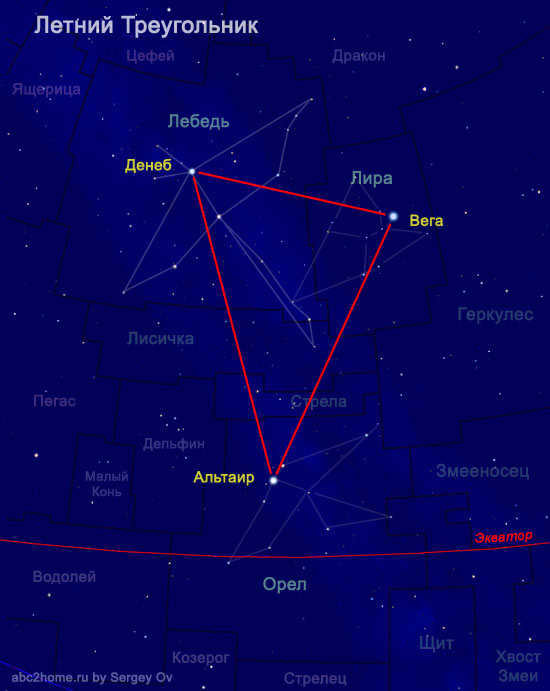 Figure 16.Aql. The seasonal asterism Summer Triangle.
Figure 16.Aql. The seasonal asterism Summer Triangle.
The History and Mythology of the Eagle Constellation
The origins of the constellation Eagle can be traced back to the 3rd millennium BC. One of the earliest known artifacts associated with this region of the sky is a relief drawing found on a cylindrical stone seal dating from 2400 – 2300 BC, known as the Seal of the scribe of the Edda. This ancient artifact depicts Enki, the god of wisdom, along with his symbolic companions Capricorn and the mythical bird Imdugut. They are surrounded by friendly gods of light forces, including Two-Faced Isimudp and the Sun God Shamash. To see a photograph of a clay seal impression showing this depiction, refer to Figure 21. Figure 21: Aql
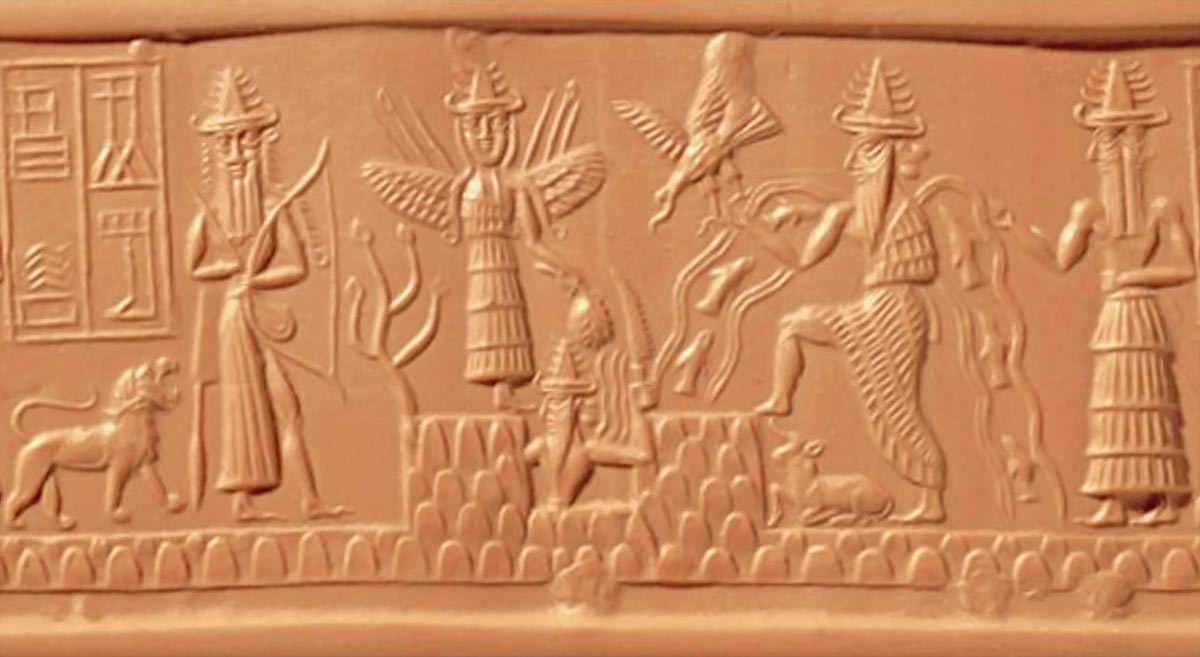
Figure 21.Aql. Clay impression of the stone seal of the Edda (The seal ADDA) that dates back to 2300 BCE. To view the complete original image of the impression, click on the figure.
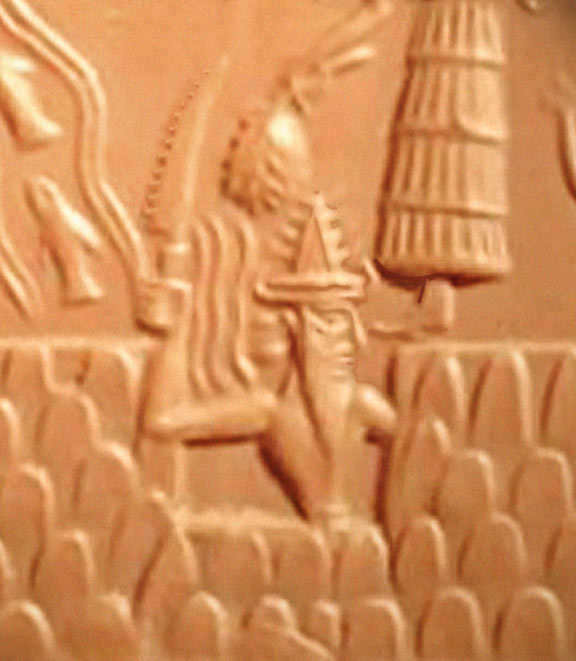
The possibility of projecting the sketch onto the night sky can be achieved by mirroring it. The results of mirroring a fragment of a print are shown in Figure 22.Aql.:
Figure 22.Aql. depicts Sun-god Shamash with the Fire Sword. By scaling the figure 22.Aql multiple times, a pattern of stars that closely resemble the image of the Sun God Shamash was discovered. It was found that the divine celestial image corresponds to 7 modern constellations: Capricorn, Eagle, Hercules, Serpent, Snake, Scorpio, and Sagittarius.
The compatibility of the image of Shamash on the seal of the Edda with the pattern of the starry sky is clearly demonstrated by Figure 23.Aql.:
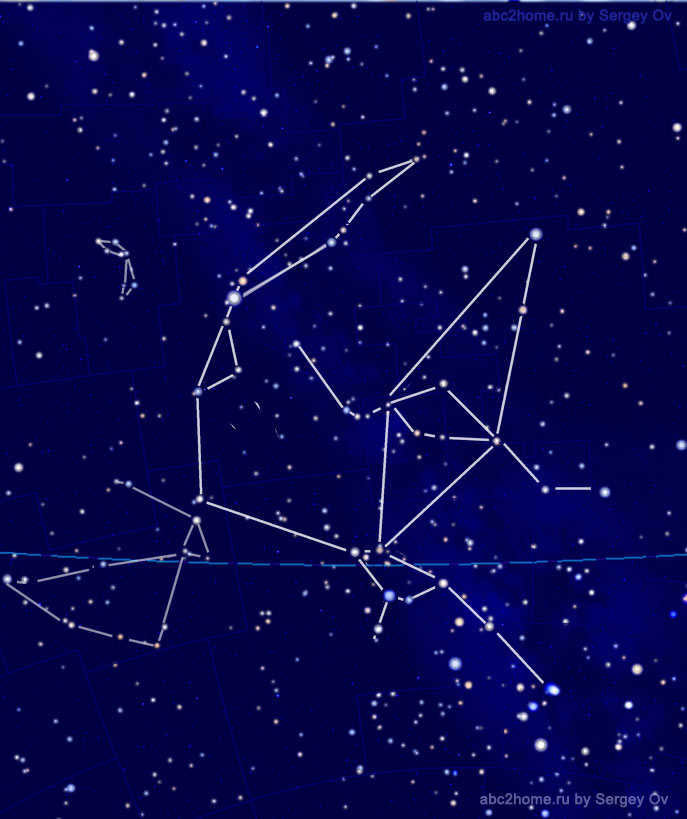
Sergey Ov’s artwork titled “Shamash with the Fire Sword” is truly captivating.
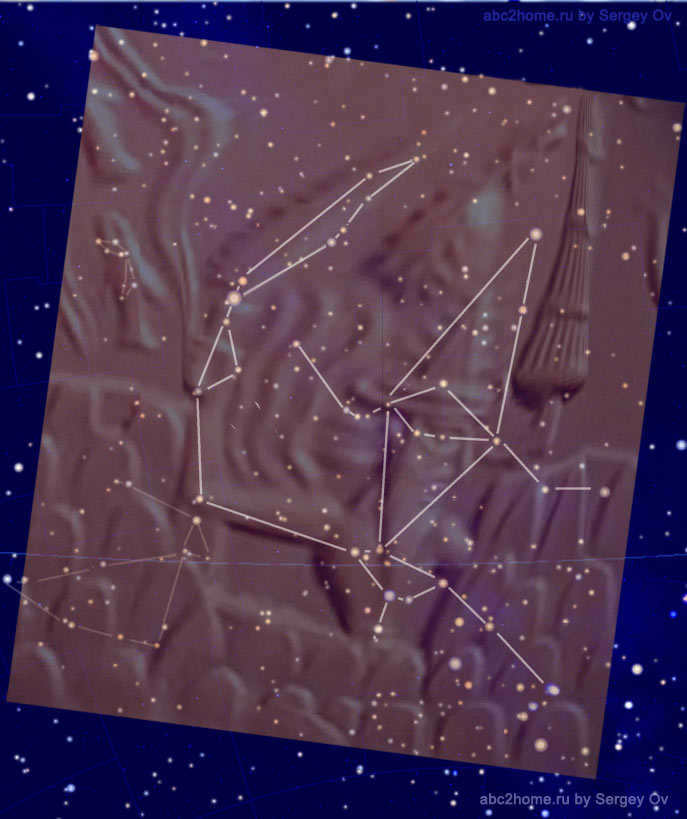
Figure 23.3.Aql. The arrangement of the celestial map featuring the names of contemporary constellations and the depiction of Shamash holding the Fire Sword.
Figures 23.Aql. A magnified section of a stone seal impression (The seal ADDA). The drawing is showcased in a mirrored image. The alignment of the celestial map and the representation of Shamash with the Fire Sword.
The representation of the Assyrian deity Ashshur, created using ancient symbolism, can be seen in Figure 24.Aql.. 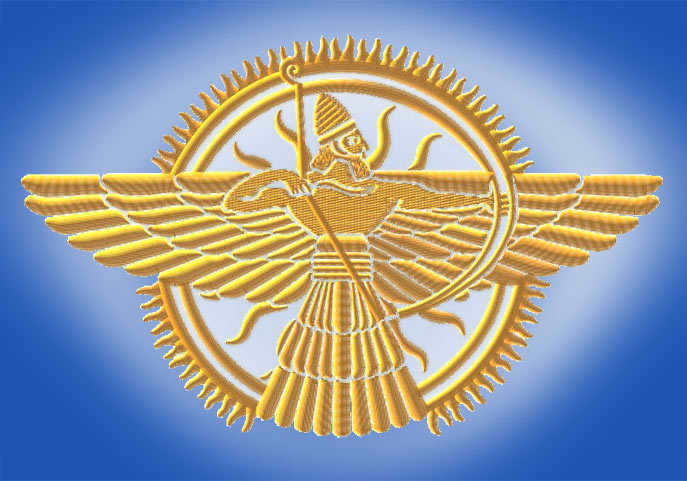 Figure 24.Aql. depicts the Assyrian God Ashshur in a collage made from contour sketches of ancient relief images. In the 10th century AD, the Persian astronomer al-Sufi (Abu-l-Hussein Abdurrahman ibn Umar al-Sufi) presented a prototype of a sitting eagle in his Book of Fixed Stars, following Ptolemy. However, according to local eastern tradition, a soaring eagle is depicted in this position. Al-Sufi portrays a stationary eagle with spread wings in Fig. 25.Aql.:
Figure 24.Aql. depicts the Assyrian God Ashshur in a collage made from contour sketches of ancient relief images. In the 10th century AD, the Persian astronomer al-Sufi (Abu-l-Hussein Abdurrahman ibn Umar al-Sufi) presented a prototype of a sitting eagle in his Book of Fixed Stars, following Ptolemy. However, according to local eastern tradition, a soaring eagle is depicted in this position. Al-Sufi portrays a stationary eagle with spread wings in Fig. 25.Aql.: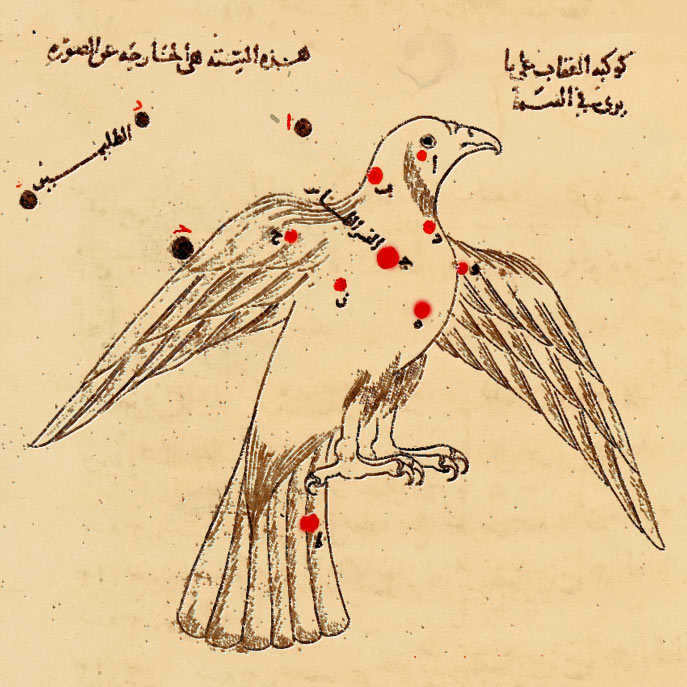 Fig. 25.Aql. shows the constellation Eagle in al-Sufi’s Book of Fixed Stars (Al Sufi. Book of the constellations, or fixed stars. – Bodleian copy: Suwar al-Kawakib al-Thabitah (Book of fixed Stars), a copy written by al-Sufi’s son in Iran in 1009). In Jan Hevelius’ atlas Uranographia, published in 1690, two constellations are depicted in place of the modern constellation of the Eagle – the proper Eagle constellation with a picture of a soaring bird from an unusual perspective, and a drawing of a very young Antinoeus.
Fig. 25.Aql. shows the constellation Eagle in al-Sufi’s Book of Fixed Stars (Al Sufi. Book of the constellations, or fixed stars. – Bodleian copy: Suwar al-Kawakib al-Thabitah (Book of fixed Stars), a copy written by al-Sufi’s son in Iran in 1009). In Jan Hevelius’ atlas Uranographia, published in 1690, two constellations are depicted in place of the modern constellation of the Eagle – the proper Eagle constellation with a picture of a soaring bird from an unusual perspective, and a drawing of a very young Antinoeus.
The constellation Antinoeus was proposed in the second century AD in honor of a deceased favorite of the Roman emperor. Since this constellation is not included in Ptolemy’s Almagest, many astronomers did not recognize it, and others did not approve of the emotions associated with its inclusion. The drawing of the constellation is shown in a collage based on a picture from Jan Hevelius’ atlas, which has been mirrored to give a view “from within the celestial sphere”: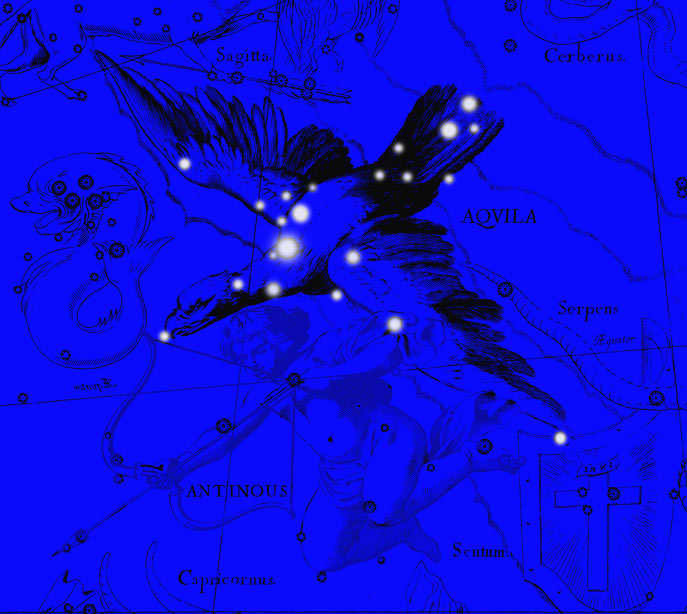 Figure 26.Aql. shows the constellation Eagle in a collage based on a picture from Jan Hevelius’ atlas (only the stars entered by Hevelius himself in the atlas and located on the figure of the Eagle are highlighted). Sergey Ov ( Seosnews9 )
Figure 26.Aql. shows the constellation Eagle in a collage based on a picture from Jan Hevelius’ atlas (only the stars entered by Hevelius himself in the atlas and located on the figure of the Eagle are highlighted). Sergey Ov ( Seosnews9 )
Illustrations for the article: The constellation Eagle, Aquila (Aql), is the oldest constellation of the Hercules group
Illustrate each page individually:
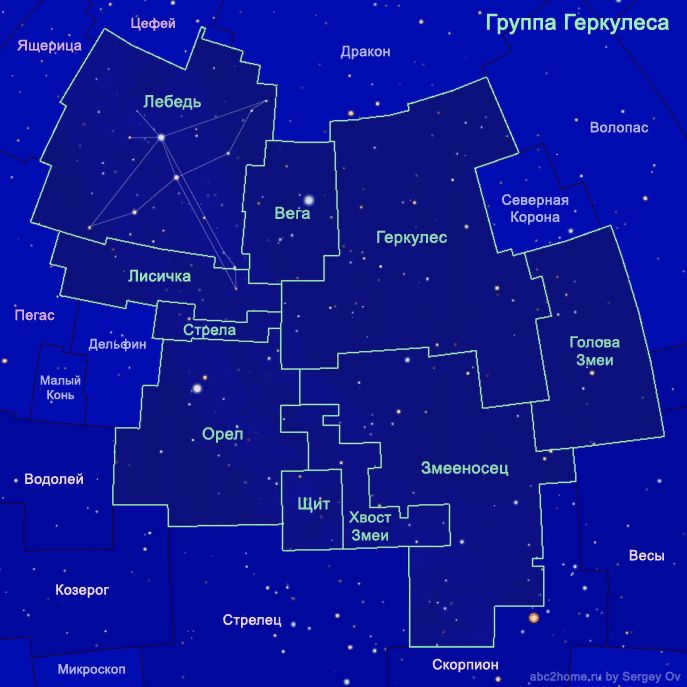
1. The constellations that belong to the Hercules group include:
Swan, Lyra, Hercules, Fox, Arrow, Eagle, Shield, Serpent, and Serpentine. Figure 16.Her. The constellation group of Hercules 2. Asterism – a collection of stars that form a distinct pattern and have their own unique name. An asterism can either be a part of a constellation, like the Throne, or it can combine multiple constellations, like the Summer Triangle.
Literature:
. Ptolemy C. Almagest: A mathematical work in thirteen books: Translated from ancient Greek by I.N. Veselovsky. – Published in Moscow: Nauka. Fizmatlit, 1998. – 672 pages. – Page 235. . Sūfi, Abd al-Rahman ibn Umar, 903-986: Kitāb Suwar al-kawākib (al-thābitah) [Book of pictures of the fixed stars] – Dated 1009-10 (A.H. 400); Held in the Bodleian Library. – p. 419. – Pages 145 – 146. . Richard Hinckley Allen: Star Names – Their Lore and Meaning, reprinted in the Dover edition, 1963. . Bolshaya Sovetskaya Encyclopedia: in 30 volumes / Edited by A. M. Prokhorov. – 3rd edition. – Moscow: Sov. encyclopedia, 1969 – 1978.
The Eagle constellation is one of the 88 officially recognized constellations by the International Astronomical Union.
Situated in the Northern Hemisphere, the constellation hosts numerous luminous stars. In Latin, the name of the constellation signifies “eagle”.
Ptolemy, the Greek astronomer, first documented the Eagle constellation in the second century AD. This celestial formation, positioned on the celestial equator, was discovered alongside Antinoeus, a now-obsolete constellation.
The Babylonian Eagle (MUL.A.MUSHEN) likely influenced the Greek Eagle, as both constellations inhabit the same region. The Eagle constellation has two meteor streams, namely June Aquilides and Epsilon Aquilides.
This configuration holds significance not just in Greek and Roman mythology, but also in various other societies. Each society interprets the configuration in its own unique manner.
Continue reading to uncover more intriguing details about the Eagle configuration and its most prominent star below.
Anatomy of the Eagle configuration
Every configuration, composed of numerous stars, possesses a distinct shape and arrangement that sets it apart from others. The arrangement and alignment of the Eagle configuration, along with the associated facts, are outlined as follows.
The Eagle configuration takes the form of a soaring eagle: within this configuration, the stars are positioned in a line that resembles the head and wings of an eagle.
The eagle constellation features a series of three stars that form what appears to be the head of an eagle. One of these stars stands out as the brightest in the entire constellation.
Additional stars in the constellation create the shape of the eagle’s neck and wingspan.
With its expansive coverage of 652 square degrees of sky, this particular constellation is easily identifiable.
Surrounding the eagle stars are neighboring constellations such as Capricorn, Hercules, Aquarius, Delphinus, Sagittarius, Shield, Serpens, and Serpens Cauda.
The tips of the wings extend towards the southeast and northwest, while the eagle’s head stretches towards the southwest.
Significance of the Eagle constellation
While not part of the zodiac, the Eagle constellation holds great importance in various cultures. Discover some intriguing details about the meaning behind the Eagle constellation below.
Attributed to the ancient Romans, the constellation was linked to their deity Jupiter, often depicted as an eagle with a lightning bolt.
In Greek mythology, the constellation is associated with Zeus, the god who employed an eagle to bear lightning bolts.
According to one Greek myth, Aquila was dispatched by Zeus to transport the young Trojan boy Ganymede to Olympus, where he would serve as the gods’ cupbearer.
The nearby constellation Aquarius is believed to represent Ganymede.
According to a different myth, a magnificent eagle serves as a guardian for the arrow of Eros (represented by Sagitta) that pierced Zeus and caused him to fall madly in love.
Another legend tells of Aphrodite transforming into Aquila in order to chase after Zeus who had taken the form of a swan.
As the story goes, Zeus immortalized the event by placing images of a swan and an eagle in the night sky as constellations.
The constellation of Aquila is also linked to the tale of Heracles bravely slaying an eagle as he attempted to free Prometheus from its clutches.
In Hindu mythology, the Eagle constellation is associated with the deity Garuda, a half-man, half-eagle figure.
In Ancient Egyptian mythology, there is a possibility that Aquila represented the falcon of Horus.
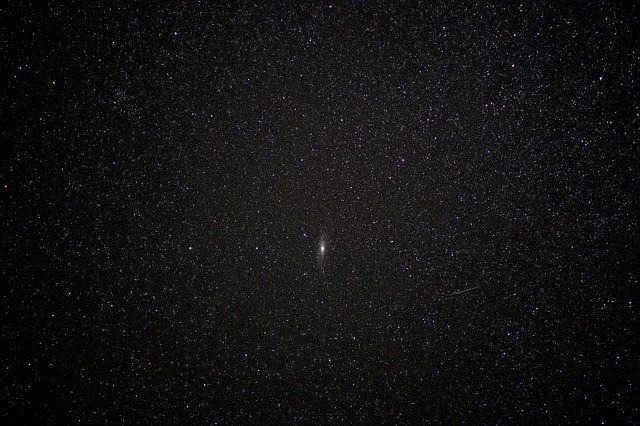
Stars in the Eagle Constellation
The Eagle constellation contains approximately eight to ten major stars, as well as several smaller stars that accompany them. Below are some of the notable stars in this constellation.
One of the most prominent stars in Eagle is Altair, which is also the 12th brightest star in the entire sky.
Altair derives its name from the Arabic phrase “al-Nasr al-tair”, meaning “flying eagle”.
This brilliant star forms a triangular pattern with Deneb and Vega, often referred to as the Summer Triangle.
Eagle is classified as an A-type main-sequence star, specifically a hydrogen fusion dwarf star, and it has three visible companion stars.
Altair is one of the nearest stars to Earth, located approximately 16.8 light-years away, and it is visible to the naked eye.
Altair is not perfectly spherical due to its rapid rotation; instead, it is flattened at both poles.
Tarazed, the second brightest star in Orl, gets its name from a Persian (Iranian) phrase that translates to “beam of scales.”
Located 461 light-years from Earth, Tarazed is a bright giant of the K-class category (spectral class K3).
Being about 100 million years old, Tarazed is already in the process of burning helium in its core to produce carbon and is also a known source of X-rays.
Alshine, also called Beta Aquila, is another significant star in the Eagle constellation.
It is the seventh brightest star in Eagle and is situated approximately 44.7 light-years away from Earth.
Alshain is classified as a Class G subgiant and its name translates to “(peregrine) falcon”.
Deneb el-Oqab, also identified as Epsilon Aquila, forms a part of the constellation Eagle.
This triple star system is situated 154 light years away from our location.
The name of this star system is derived from an Arabic expression that means “tail of the eagle”.
Representing the brightest element of Eagle’s Epsilon is a massive, orange-colored K-type star known as Barium Star.
Deneb el Okab is also the designation for Zeta Aquila.
To differentiate between the two stars, Eagle’s Epsilon is referred to as Deneb el Okab Borealis, while Eagle’s Zeta is called Deneb el Okab Australis, based on their respective positions.
Zeta Orla of Orla is another triple star system that is located 83.2 light-years away from Earth.
The primary star of this system is a dwarf with a white coloration and of the A-type main-sequence.
Bezeq, also known as Eta Aquila, is a significant star in the Eagle constellation.
Located approximately 1,200 light-years away from Earth, Eta Aquila is a yellow-white supergiant.
This variable cepheid star is easily identifiable to the naked eye.
The name “Bezeq” is derived from a Hebrew phrase meaning “lightning”.
Theta Orla, another star in the Eagle constellation, is a spectroscopic double star situated around 287 light-years distant.
Also known as Qing Fu, this star’s name originates from the Mandarin word “tianfu”, which translates to “celestial rafters” or “drumsticks”.
The combination of Theta Aquilae, Eta Aquilae, 58 Aquilae, and 62 Aquilae forms an asterism referred to as the “celestial drumsticks” in Chinese culture.
Iota Eagle and Lambda Eagle are celestial objects located within the Al-Talimein constellation, commonly known as the Eagle constellation.
Iota Eagle is classified as a B-type star, while Lambda Eagle is a B-type main-sequence dwarf star; both stars exhibit a distinctive blue-white hue.
The name Al-Talimein is derived from an Arabic term, which translates to “two ostriches”.
To distinguish between these two stars, Lambda Eagle is referred to as Al-Talimein Prior.
Aquila also features an orange giant star known as 15 Aquilae, which can be easily observed using small telescopes.
Prior to 1992, Ro Aquila, an A-type white main-sequence dwarf star, was considered a part of Aquila. However, it eventually drifted away from the boundary and is now classified under the Delphinus constellation.
Deep space objects in the constellation of Eagle
While the constellation of Eagle does not consist of Messier objects, it does contain a variety of other deep space objects. Here are a few examples:
One notable deep space object in the constellation of Eagle is the Planetary Nebula, which was initially spotted by the American astronomer Edward Charles Pickering in 1882.
This particular planetary nebula is referred to as the Phantom Band Nebula or NGC 6741 for observational purposes.
Located approximately 7,000 light-years away from us, the Phantom Lane Nebula is relatively small in size.
Another fascinating deep space object in the constellation of Eagle is the scattered star cluster NGC 6709, which is situated near Zeta Eagle in the southwestern direction.
This scattered star cluster, which has a loose diamond shape, was discovered by William Herschel in 1828.
NGC 6709 is easily identifiable using small telescopes.
The constellation also contains Barnard’s E Nebula, also known as E Nebula.
E Nebula is composed of the dark nebulae 142 and 143, known as the Barnard nebulae.
It is located west of Tarazed and is approximately 2000 light years away from Earth.
Another planetary nebula that can be found in the constellation of Eagle is NGC 6781, which bears some resemblance to the Owl Nebula (Messier 97) in the Big Dipper constellation.
The discovery of NGC 6781 was credited to William Herschel in July 1788.
NGC 6803 and 6804 are two planetary nebulae that are situated very close to each other.
Edward Charles Pickering discovered NGC 6803 in 1882, while NGC 6804 was discovered by William Herschel in 1791.
The planetary nebula NGC 6751 is commonly referred to as the Luminous Eye Nebula.
The nebula is positioned approximately 6,500 light years away from Earth and can be observed in the vicinity of Lambda Aquila towards the southern region.
NGC 6760, which is visible in the Eagle constellation, is a globular cluster that is situated roughly 24,100 light-years from our planet.
It was initially discovered by John Russell Hynde in 1845 and documented as GC 4473.
Later on, it was given its current name by John Louis Emile Dreyer.
NGC 6778, also referred to as NGC 6785, is another planetary nebula located in the Eagle constellation.
This particular bipolar nebula features a highly condensed equatorial ring.
What initially captivates us about the night sky are the constellations, which are a collection of stars that form recognizable patterns. When we see photos of constellations and their names, they often appear more coherent than actual celestial drawings and their designations. This is because the images are typically accompanied by guiding lines and don’t have any distracting elements that can interfere with our perception. However, the true beauty of constellations can only be fully appreciated by observing them directly in the night sky.
To make it easier to locate specific stars and constellations, the Earth’s sky is divided into northern and southern hemispheres along the equator. The equatorial constellations, such as the mythical servant of Zeus known as the Eagle, are positioned directly on this dividing line.
Where to Find the Eagle Constellation
The Eagle constellation is positioned near the celestial equator, making it visible from almost any location around the globe. For those in the northern hemisphere, the ideal time to observe the constellation is during the months of July and August. With approximately one hundred stars that can be seen without the aid of a telescope, the Eagle constellation is a stunning sight. Many of these stars are situated along the eastern portion of the Milky Way.
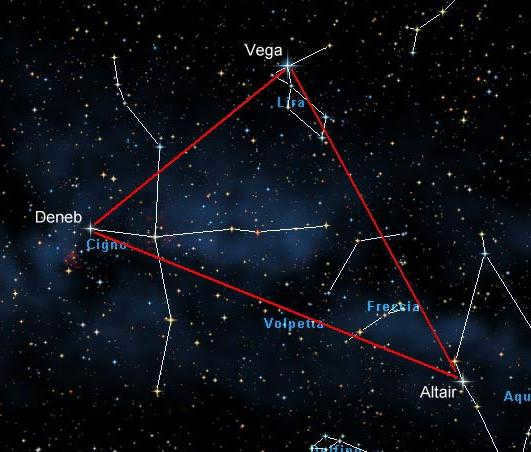
Altair, the most brilliant star in the Eagle constellation, is a component of the Summer Triangle asterism. The other two points of the triangle are Deneb, associated with the celestial representation of the Swan, and Vega, also known as alpha Lyra, the second brightest star in the northern hemisphere. This close proximity between Altair and the other two stars makes it easier to locate both Altair itself and the entire Eagle constellation in the night sky.
Legend
Stories and folklore surrounding constellations often explain the origins of their formation in the night sky and offer interpretations of their names. The Eagle, a noble creature, possesses great power, grace, and a vast wingspan, but it lacks the ability to illuminate the world beyond the realm of the living once it passes away.
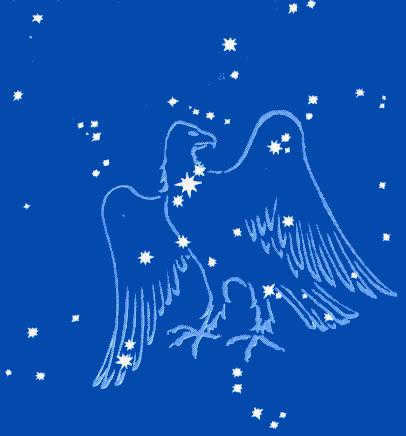
According to ancient stories, the Eagle, which illuminates the nighttime sky, once served as a loyal companion to Zeus, the formidable god of the ancient Greeks. He was bestowed with the great privilege of carrying Zeus’s thunderbolts and delivering them whenever they were needed. Zeus entrusted his Eagle with important tasks and missions. Occasionally, the Eagle would bring the god the individuals he required, as seen in the myth of Ganymede. The Eagle also served as a tool of punishment for Zeus, targeting the guilty. One of the most prominent legends and myths associated with constellations is the tale of Prometheus. The Eagle in this story was the very same bird that tormented the titan on a daily basis for bestowing fire upon humanity. Prometheus endured immense suffering until he was ultimately rescued by Heracles, who killed the Eagle. In recognition of the Eagle’s faithful service, a sorrowful Zeus immortalized the bird in the heavens.
Alpha
can be paraphrased as
First letter of the Greek alphabet
.
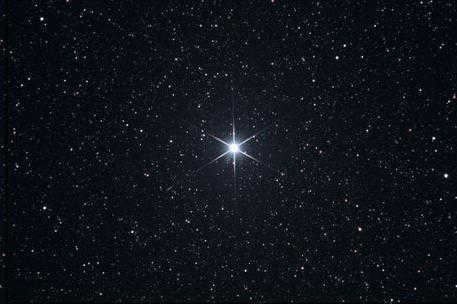
Altair is the most notable star in the constellation of the Eagle. Its name indicates its association with the celestial pattern. Altair derives from the Arabic phrase meaning “flying eagle.” It is the twelfth brightest star among all the luminaries, not only due to its size and brilliance but also because of its relatively close proximity to the Sun. Scientists estimate that it is located approximately 16.8 light-years away. Among all the objects in spectral class A, only Sirius is closer to us.
Altair, a star in the main sequence, is slightly less than twice the mass of the Sun. However, its luminosity is 11 times greater than the Sun’s. Observations have revealed that Altair’s brightness changes only by a few hundredths of a stellar magnitude. As a result, it is now classified as a Delta Scuti variable star.
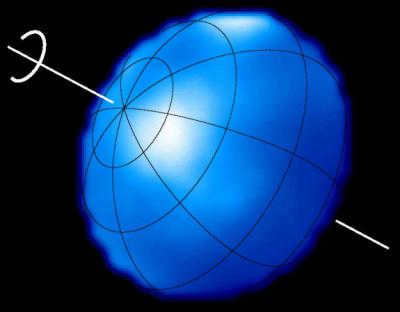
Altair has a unique shape that sets it apart from a typical sphere. The diameter of Alpha Eagle is slightly larger at the equator than at the poles, creating an inequality. This shape is a result of Altair’s high rotational speed, reaching 286 km/s near the equator. In fact, Altair completes one revolution in less than nine hours.
The centrifugal forces caused by this rapid rotation have deformed the star, causing its poles to be closer to the core than the equator line. Consequently, the poles are more heated compared to the rest of the star.
The Family of Eagles
Altair, Beta, and Gamma, which are part of this constellation, are almost perfectly aligned. They, along with a few other less noticeable stars, form the asterism known as the Eagle Family. The three prominent stars in the constellation are also referred to as the Crown of Libra. However, it is important to note that this asterism has no connection to the zodiacal pattern associated with individuals born in September. Nonetheless, it serves as a helpful guide in locating the Eagle constellation.
The triple system exists.
Alshain, also known as Eagle’s beta, is located 44.7 light-years away from the Sun and consists of three stars. The first star in this system is an orange subgiant with a stellar magnitude of 3.17. Currently, this star is undergoing a transformation and is in the process of becoming a red giant. It has a mass that is 1.3 times greater than our Sun.
Alshain’s companion, known as Beta Eagle B, is a red dwarf with an apparent luminosity of 11.4. It is significantly smaller than the first star, with a mass that is only 0.3 times that of the Sun. The third star in the system, Beta Eagle C, has an apparent brightness of +10.5.
An additional celestial body within the constellation of Eagle, which belongs to the asterism known as the Scales Crown, is Tarazet (gamma). It holds the second position in terms of brightness among all the stars in this particular celestial formation. Interestingly, the distance from the Sun to the gamma of Eagle greatly surpasses the distance to Altair and Alshain. This distance is estimated to be approximately 460 light-years. If not for this magnitude, Tarazet would surpass Eagle Alpha in brightness, as its luminosity is more than 2.5 thousand times greater than that of the Sun. The apparent magnitude of Tarazet is 2.72.
The size of Tarazet is quite remarkable: its diameter is so immense that if it were placed in the position of the Sun, it would fill the entire space up to the orbit of Venus.
Gamma Eagle is not a solitary star. Tarazet has a companion with an apparent brightness of 10.7.
Variables
The Eagle constellation contains a number of Cepheus delta type variables, also known as Cepheids. Among them is the Eagle itself, which experiences fluctuations in its brightness from 3.5 to 4.4m over a period of slightly more than 7 days. This particular variable star was first identified by E. Pigott, a year prior to Goodricke’s groundbreaking discovery of Cepheus delta variability. Additionally, there are three other observable variable stars in this stellar pattern: FF, TT, and U of the Eagle, which can be seen with binoculars from Earth.
Collaborating with a singularity
SS433, situated 18,000 light-years away from the Sun, is one of the fascinating entities within the constellation Eagle. It is an eclipsed X-ray binary system that radiates luminosity. It is believed that one of its constituents is a singularity, while the other is a star classified as spectral class A. Both objects revolve around a common center of mass, completing one orbit in approximately thirteen days.
This system originated from the explosion of a massive celestial body nearly ten thousand years ago, resulting in the creation of the W50 nebula. The singularity is the remnant of the collapsed core of a supernova.
The flow of matter from the star in the system is continuously drawn towards the black hole, creating a disk of material that encircles it and becomes heated. This increase in temperature leads to the emission of X-rays from the object’s surface, which occurs consistently. Additionally, streams of matter are expelled in various directions into the surrounding space. These jets propel themselves at a velocity approximately equivalent to one-fourth the speed of light. In essence, the depiction of the interaction between objects within the system bears resemblance to the illustrations commonly found in instructional guides, which aim to elucidate the phenomena taking place near a black hole.
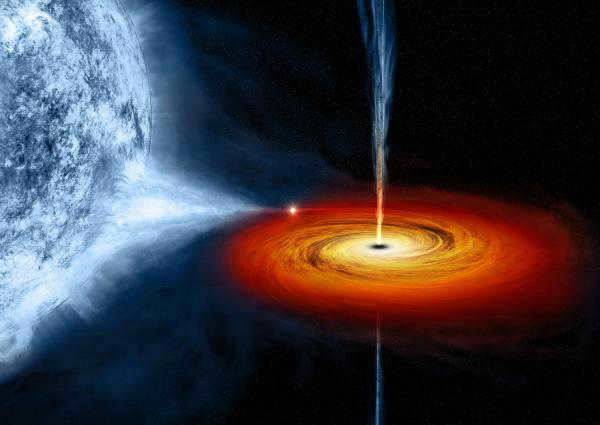
New Information
In 1999, there was an unusual phenomenon in the constellation Eagle. One of the stars in the constellation, named V1494, experienced a significant increase in brightness, reaching a factor of 70,000. This event occurred between December 1 and December 4. Scientists believe that this increase in brightness is due to a classical nova, which is a binary system consisting of a white dwarf and another companion star. In this system, matter from the companion star accumulates on the white dwarf and eventually leads to an explosion. This explosion is observed from Earth as a gradual increase in brightness. It is worth noting that the system does not disintegrate after the explosion, and the flow of matter between the two companions continues. Scientists predict that centuries later, another explosion can be expected in this system.
Several planets have been discovered around the stars in the constellation of the Eagle. One example is the star known as Xi Eagle. Xi Eagle is an orange giant star that is larger and more luminous than the Sun. It is 12 times larger and 69 times more luminous. Xi Eagle also has a greater mass than the Sun, although not by a large margin, only 2.2 times. However, the surface temperature of Xi Eagle is lower, not exceeding 5,000 degrees.
In 2008, Japanese astronomers discovered a planet orbiting Xi Eagle. This planet is classified as a gas giant and has a mass 2.8 times greater than Jupiter. It takes 136 days for this planet to complete one orbit around Xi Eagle.
Nebula
The constellation Eagle contains a stunning celestial object known as the Shining Eye Nebula or NGC 6751. Resembling a pupil, the hot star at the center of this cosmic formation emits radiation and winds that create streams, giving the appearance of colorful shimmers in the iris when observed through a telescope.

The Sparkling Eye is a traditional planetary nebula with a size approximately 600 times larger than the Solar System. The precise measurement of this parameter is estimated to be 0.8 light-years. The nebula is situated 6,500 light-years away from our star.
The Starry Image of the Eagle – another part of the sky filled with impressive entities. The depiction of the constellation, photographs, and names of individual stars carry a wealth of intriguing information. Thanks to modern technology, anyone can witness the appearance of different parts of the distant Eagle constellation, which is located many tens and hundreds of light years away from us.
What makes the information age we live in so unique is the ability to quickly access all the relevant information about a specific subject. This includes various legends about the names and origins of constellations from different nations and centuries, as well as the latest data on star features and telescope photographs. When we look up at the night sky today, we not only appreciate its beauty, but also gain a clear understanding of the incredible beauty that lies within its depths.
The Eagle constellation is situated in the equatorial region and is one of the 48 constellations that were first documented by Ptolemy, a Greek astronomer, in the 2nd century. The Romans referred to it as the “Flying Vulture.”
The Eagle constellation is situated in the Milky Way galaxy. It is encircled by the constellations of the Lesser Horse, Dolphin, Sagittarius, Capricorn, Hercules, Shield, and Arrow. Identifying it is effortless due to the three luminous stars that form an almost linear alignment on the left shoulder, back, and neck of the immense bird. Covering an expanse of 652.5 square degrees, the Eagle constellation encompasses 119 stars that are observable to the unaided eye.
The Eagle constellation reaches its highest point above the horizon during the months of August and September when the night sky is most favorable for observation. During a moonless and clear evening, it is possible to spot up to 70 stars within this constellation using only the naked eye. Among these stars, 8 are of a brightness greater than the 4th magnitude.
The most luminous celestial body
Altair, positioned in the Eagle constellation, stands out as the most luminous celestial body, boasting a magnitude of 1st. By mentally connecting the stars surrounding Altair, one can trace the shape of an eagle in flight, with its wings gracefully extended. Both the Greeks and the Arabs have recognized this majestic bird of prey, with the latter bestowing upon it the name “Altair” which translates to “flying”.
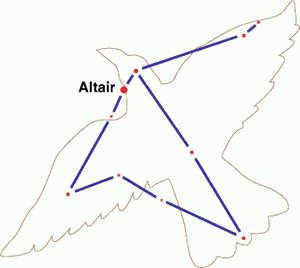
Altair, which is part of the Eagle constellation, is located relatively close to Earth. It is positioned at a distance of only 16 light years from our planet, which contributes to its remarkable brightness. Despite its proximity, Altair is only twice the size of the Sun, yet its radiation is eight times more intense. Currently, Altair is moving towards Earth at a velocity of 26 km/s. However, it will take approximately 12,000 years for Altair to come within 15 light years of our planet, bringing it a mere one light year closer. Along with Beta and Gamma Eagle, Altair contributes to the formation of the Eagle constellation’s body.
Beta, gamma, zeta, eta, epsilon and delta constellations
The constellation Eagle contains several notable stars, including Beta, Gamma, Zeta, Eta, Epsilon, and Delta. Located approximately 44.7 light years away from Earth, Beta is a star with an apparent magnitude of 3.71. Gamma, on the other hand, is a massive yellow-orange star and has an apparent magnitude of 2.72.
Zeta, within the Eagle constellation, is a fascinating triple star system. Eta, another star in this constellation, is a yellow-white supergiant that shines 3,000 times brighter than our Sun. It is one of the most prominent cepheids visible to the naked eye.
Epsilon, also part of the Eagle constellation, is another triple star system. It is led by an orange giant star and has a K-type giant atmosphere composed of barium.
Delta, the final star of interest in the Eagle constellation, is also a triple star system. Its primary celestial body is an F-type subgiant.
These fascinating stars can all be observed within the constellation Eagle, as shown in the diagram above.
Zeus’ battle with his father and the assistance of Prometheus
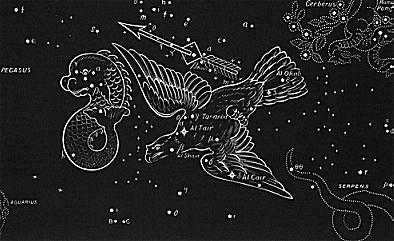
The Arrow is a compact group of stars situated within the Milky Way. Legend links the Arrow and the Eagle constellation to the destiny of Prometheus. Numerous books aimed at children have been published recently, offering a modern interpretation of the Prometheus myth. This captivating tale is not only captivating for young readers, but also for adults. Allow us to briefly recapitulate it.
When Zeus reached adulthood, he engaged in a fierce battle against his father Cronus, in order to gain control over both the Earth and the Heavens. This struggle was arduous and stubborn, as the powerful Titans supported Cronus. Zeus unleashed thunderous roars and unleashed fiery lightning bolts upon them. Even with the assistance of the hundred-armed hecatoncheires, who were as colossal as mountains, Zeus emerged victorious, banishing the Titans to the dark depths of Tartarus. Only one among them, Prometheus, refrained from fighting against Zeus. Instead, Prometheus aided him in the battle and convinced his mother Themis and the goddess Gaea to join his cause. As a result, Prometheus was granted the privilege to reside among the gods on Mount Olympus, and he retained the ability to descend to Earth at his leisure.
Prometheus’ resolve to assist humanity
Nevertheless, the perpetual revelry of the deities on Mount Olympus and their carefree existence failed to captivate Prometheus. He descended to Earth and resolved to dwell among mortals and provide aid. Witnessing the abject suffering of the planet’s inhabitants, his heart shattered with anguish – they endured freezing conditions in holes and caves, lacked fire, succumbed to countless ailments, and had to fend off wild beasts. Recognizing that fire would alleviate their misery, Prometheus resolved to bestow it upon humanity. However, Zeus prohibited him from sharing fire with humans, fearing that they would usurp the gods’ dominion over the world.
Prometheus has a positive impact on individuals’ lives
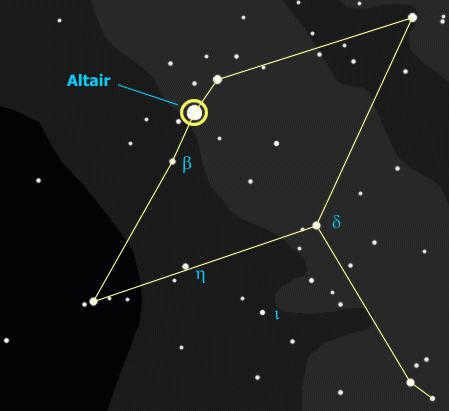
Prometheus understood the consequences that awaited him if he defied Zeus’ prohibition. However, he could not simply stand by and witness the agony and anguish of humanity. Consequently, he made the bold choice to pilfer fire from Hephaestus’ workshop and bestow it upon the people. Additionally, Prometheus took it upon himself to educate them in the proper utilization of this newfound element.
People’s lives underwent a rapid transformation for the better. They ceased to endure freezing temperatures in caves, abandoned the consumption of raw meat, and began to prepare their own meals. However, Prometheus bestowed upon humanity not only the gift of fire. He educated them on the art of extracting ores from the depths of the earth, smelting them using fire, and obtaining a diverse range of metals. These metals were then utilized to create plows and tools. Prometheus also instructed them on how to domesticate wild horses and bulls, harness their power, and utilize them for agricultural purposes. Additionally, he tamed wild goats and sheep, providing people with a sustainable source of meat and milk for nourishment, as well as animal skins for clothing. Furthermore, Prometheus taught individuals the skills necessary to heal illnesses.
The fury of Zeus
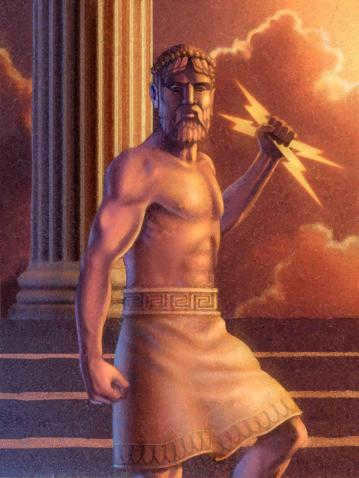
Zeus, undoubtedly, felt a surge of anger towards the titan who dared to defy him. As punishment for his disobedience, Prometheus, the devoted servant of this mighty god, was subjected to the weight of heavy chains. These chains bound him tightly and he was taken to the very edge of the Earth, to a place known as the Caucasus. Here, one could witness the majestic sight of rocky peaks that seemed to touch the clouds, while the seashore remained barren, devoid of any signs of life. Not a single tree or blade of grass could be found in this desolate place, only formidable rocks stood as a testament to the power of nature. It was upon these rocks that the relentless waves of the sea crashed with a thunderous roar, serving as a constant reminder of Prometheus’ eternal punishment.
At the behest of Zeus, Hephaestus arrived at this desolate place. With the weight of his duty upon him, Hephaestus bound Prometheus to the cliff using an iron hammer. The sound of metal striking against metal resonated through the air as an iron point was driven into Prometheus’ chest. And so, the centuries went by, with Prometheus enduring his agonizing punishment without respite.
The Oceanids pay a visit to Prometheus.
One fine day, the calmness of the sea prevailed. Riding on majestic golden chariots, the Oceanids, who were the daughters of Oceanus, arrived with a gentle breeze to meet Prometheus. Among them was Hesione, who happened to be the wife of this mighty titan. Accompanied by them was the wise Oceanus himself, who appeared on a chariot with wings. His intention was to persuade Prometheus to reconcile with the furious deity, but Prometheus was not open to hearing any of it. He alone held the knowledge of the secret that posed a threat to his dominion over the planet.
Titan experiences a descent into darkness
In search of Zeus’s hidden destiny, Hermes, the divine messenger, hastened to Prometheus. Yet, Prometheus remained resolute in his refusal to divulge the secret. Enraged, Zeus summoned thunder and lightning upon the rock where Prometheus was bound, casting it into an eternal abyss of darkness. Millennia later, the deity resolved to extricate the defiant titan from his lightless confinement and subject him to immense suffering. The scorching rays of Helios seared his flesh, the rock scorched beneath the sweltering summer sun. Torrential rains and hail battered his weary body, while delicate snowflakes gently descended upon him in winter.
A majestic bird nibbling at the liver of Prometheus.

Every day, when the sun rose and the sky was ablaze with Helios’ fiery chariot, Zeus would send his enormous eagle to visit Prometheus. With a thunderous sound of powerful wings, the eagle would soar up to the great rock where Prometheus lay. It would land gracefully on his chest, its sharp talons tearing into the titan’s flesh and pecking at his liver. Each time, streams of blood would flow, drenching the rock in a crimson cascade. Only when Helios descended to the western Ocean on his knee would the eagle finally fly away. As night fell, Prometheus’ wounds would miraculously heal, his liver regenerating. Yet, as the morning light dawned, the agonizing cycle would begin anew. Thus, these excruciating torments endured for a staggering 30,000 years.
Hercules rescues Prometheus
One day, Themis, who was Prometheus’ mother, approached the titan and implored him to make amends with Zeus and reveal her secret. Nonetheless, Prometheus remained resolute. He was aware that the hero destined to end his suffering had already come into the world. That hero was Hercules, a renowned traveler who had saved countless people from various monsters and calamities. Finally, Hercules arrived at the distant reaches of the Earth. As he stood before a towering rock, Hercules gazed upon Prometheus, who was bound to it, and attentively listened to his tale.
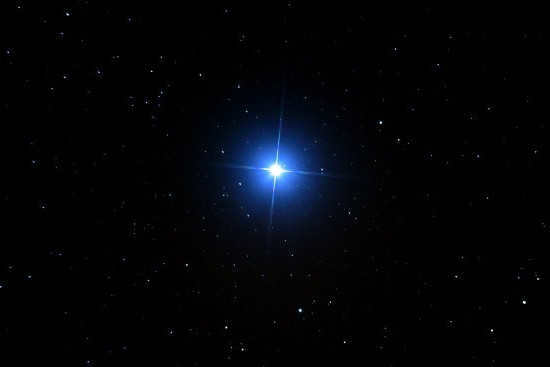
All of a sudden, the sky resounded with the flapping of wings as a massive eagle materialized in the heavens. It poised itself to swoop down upon the titan. Hercules readied his bow and drew back the string. With a piercing whistle, the arrow found its mark, penetrating the eagle’s body. Like a plummeting stone, the mighty bird plummeted into the depths of the sea. In a flash, Hermes, the messenger of Zeus, descended from Mount Olympus. He turned to Prometheus and offered the titan his freedom if he would disclose the secret of how Zeus could avoid his inevitable doom. Eventually, Prometheus acquiesced and warned the thunder god against marrying Thetis, the sea goddess, for the fates had decreed that she would bear a son who would surpass his father in power.
Hercules shattered Prometheus’ chains and tore the iron spearhead from his heart. In the nights of summer and even now, Hercules remains visible in the heavens. He gazes up at the ravenous Eagle, with the Arrow positioned above him. Prometheus alone is absent from the celestial landscape, yet mankind will forever remember the one who bestowed upon them wisdom and fire – weapons to challenge the might of the deities.
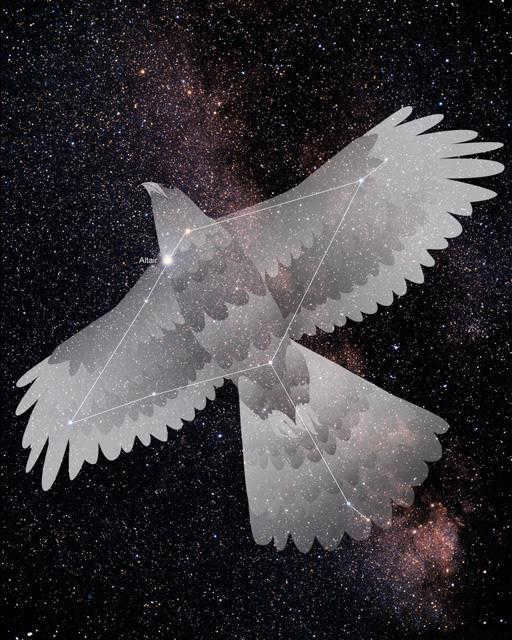
Artistic and Literary Depictions of the Mythical Figure Prometheus
The constellation of the Eagle is associated with this tale in mythology. The aforementioned legend remains highly renowned in present times. It is particularly popular in art and literature. Aeschylus, for instance, authored several tragedies linked to the name of the mighty titan: “Prometheus chained”, “Prometheus the Firebringer”, “Prometheus freed”. Aristophanes wrote the comedy “The Birds”, Actsius wrote the tragedy “Prometheus”. The humanistic qualities of this depiction of the rebellious martyr were further explored in poetry (Shelley, Byron, Ogarev, Gautier, Shevchenko, and others), in music (Scriabin, Liszt, etc.), and in the fine arts (Gordeev, Titian, etc.). Calderon’s drama “Enlightenment” and the works of Beethoven and Goethe reflected the late antique version of this myth. In this interpretation, Prometheus serves as the creator of humans, whom he fashioned out of the soil.

